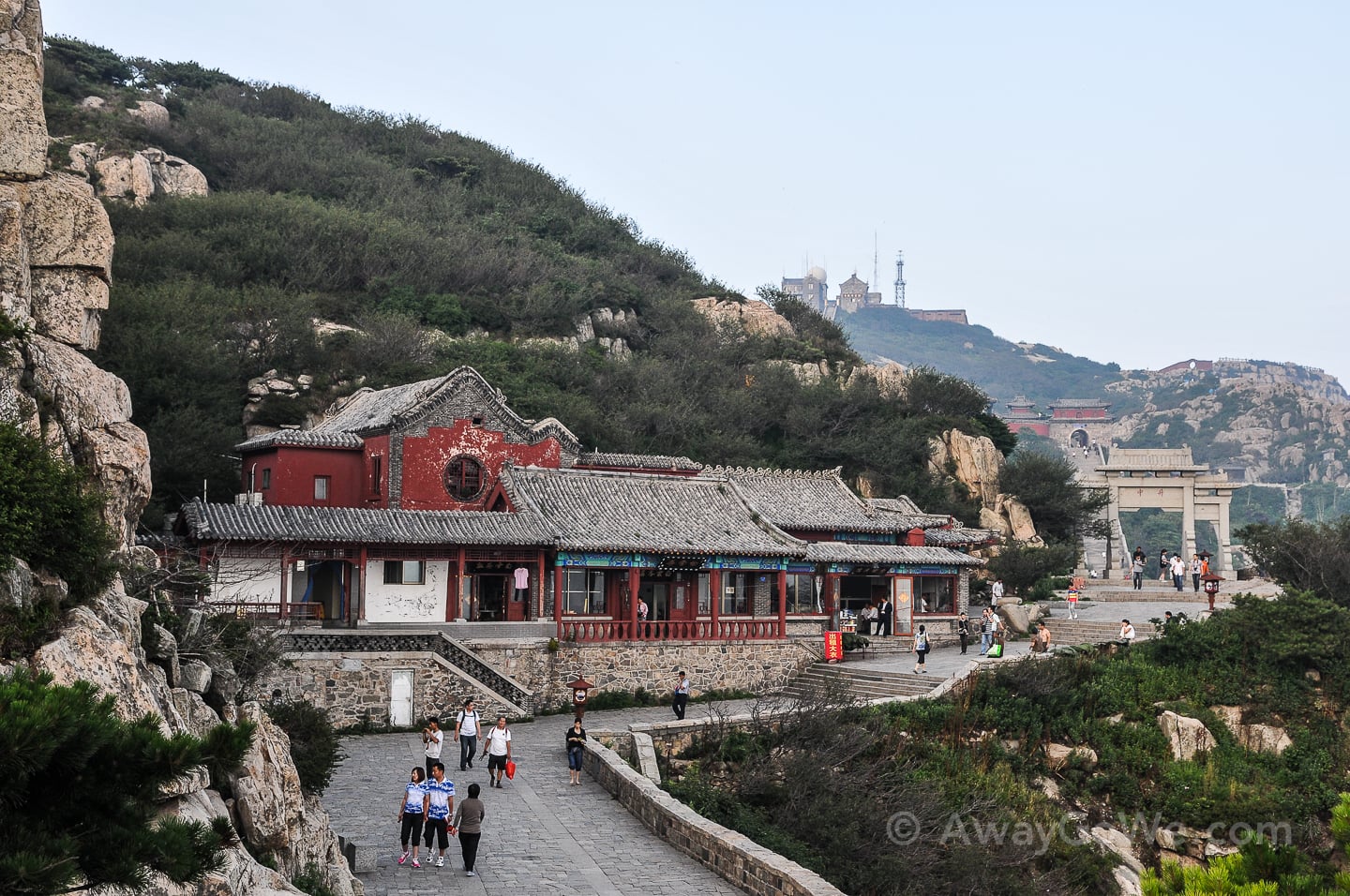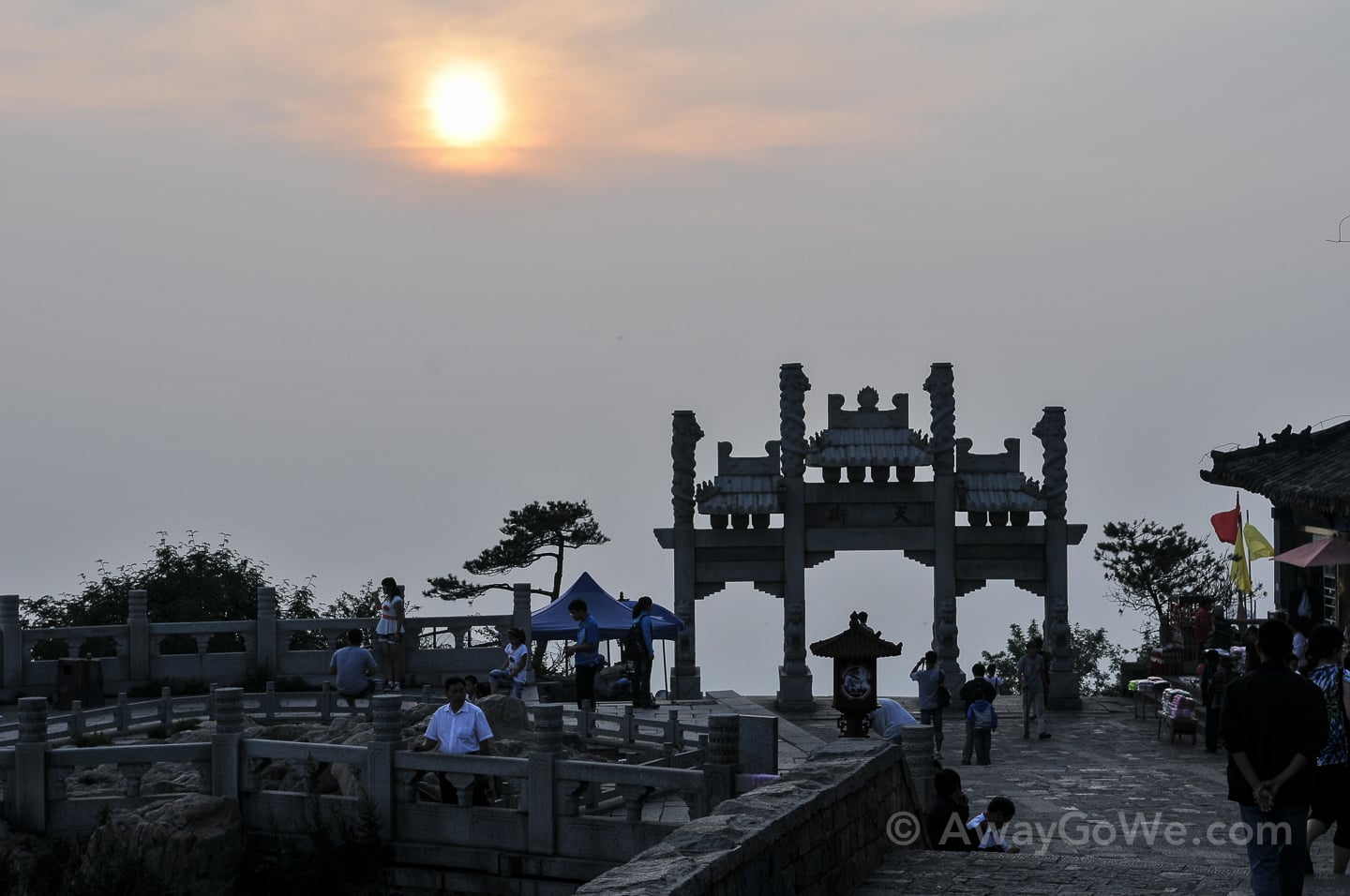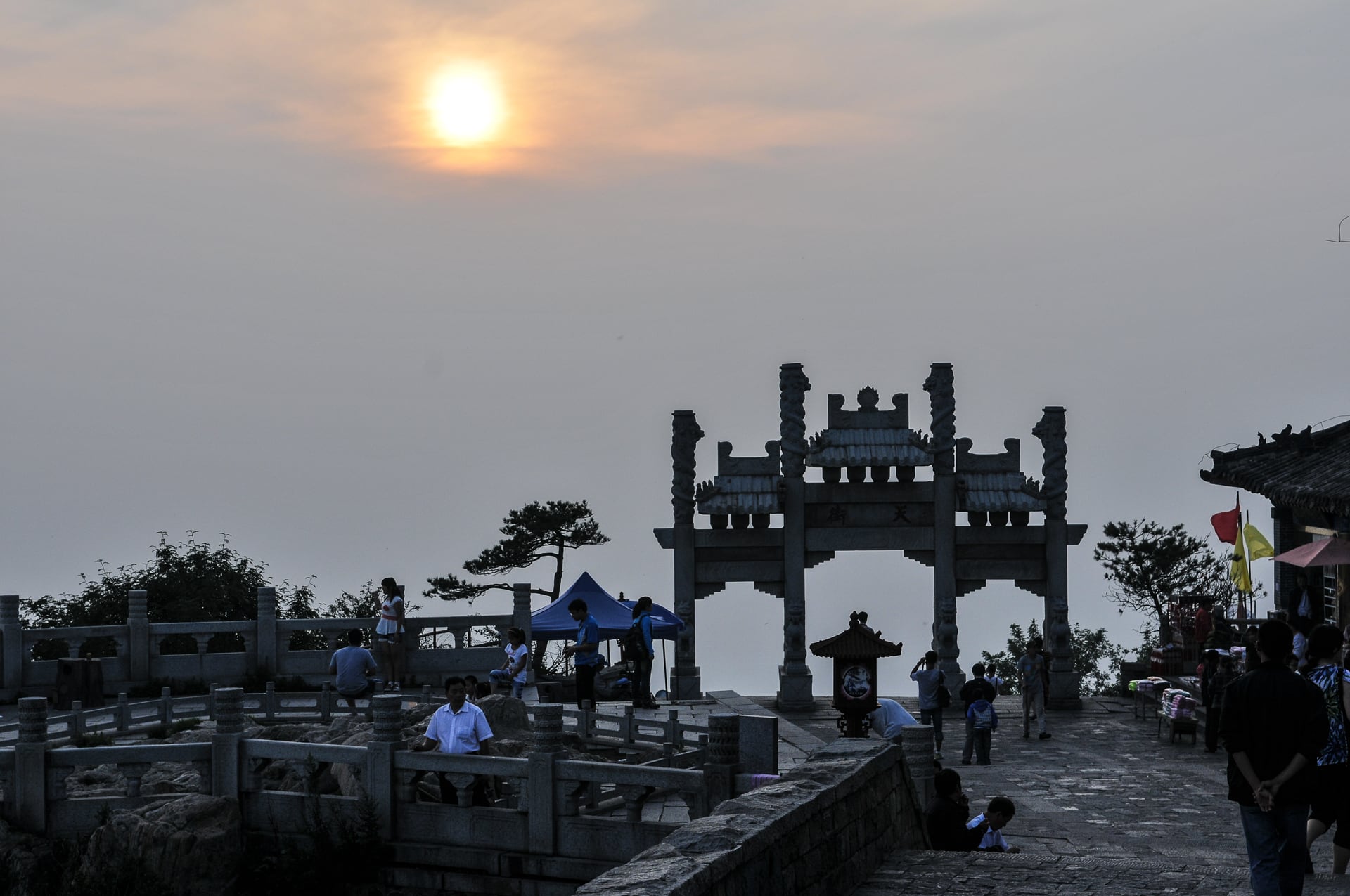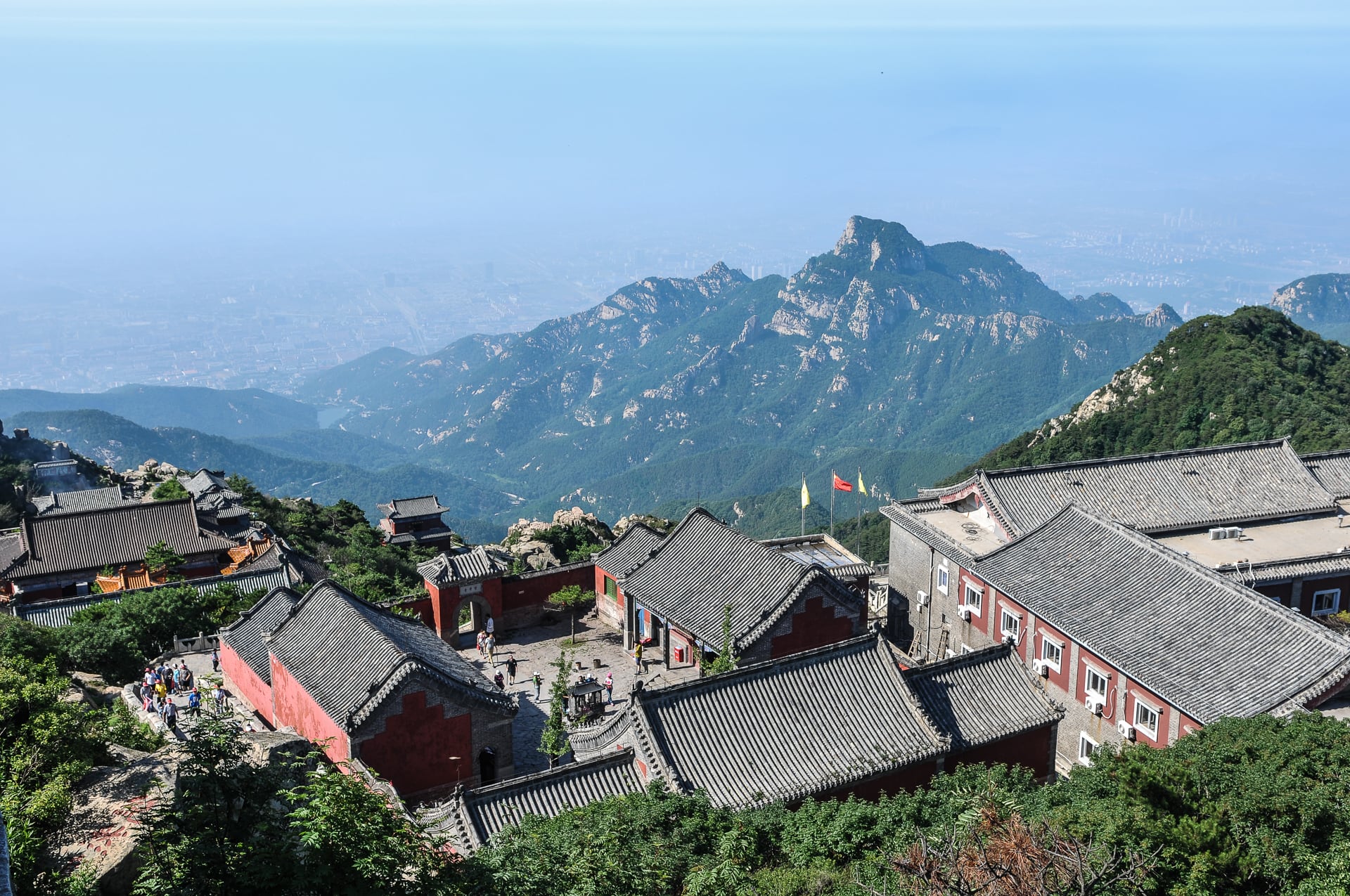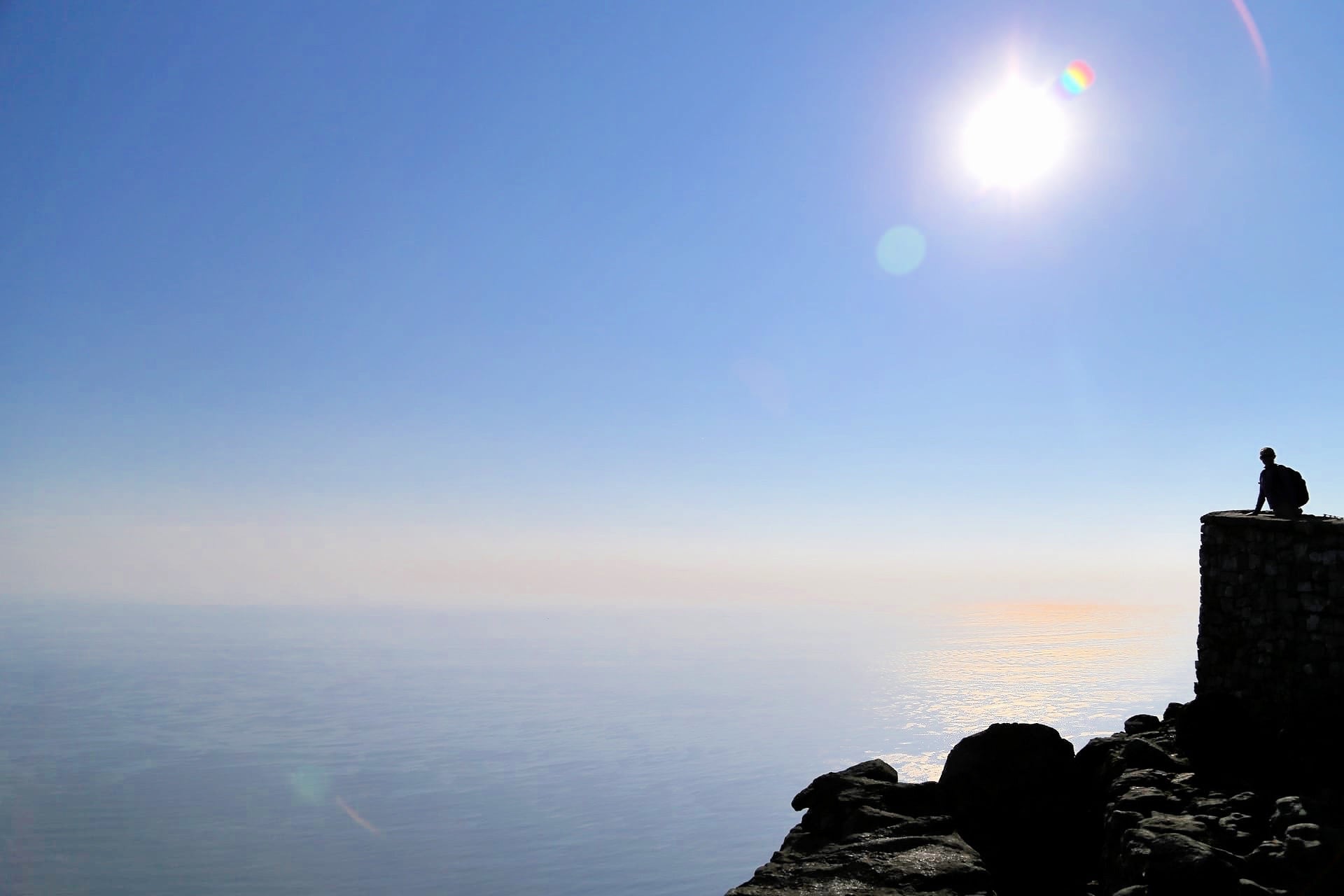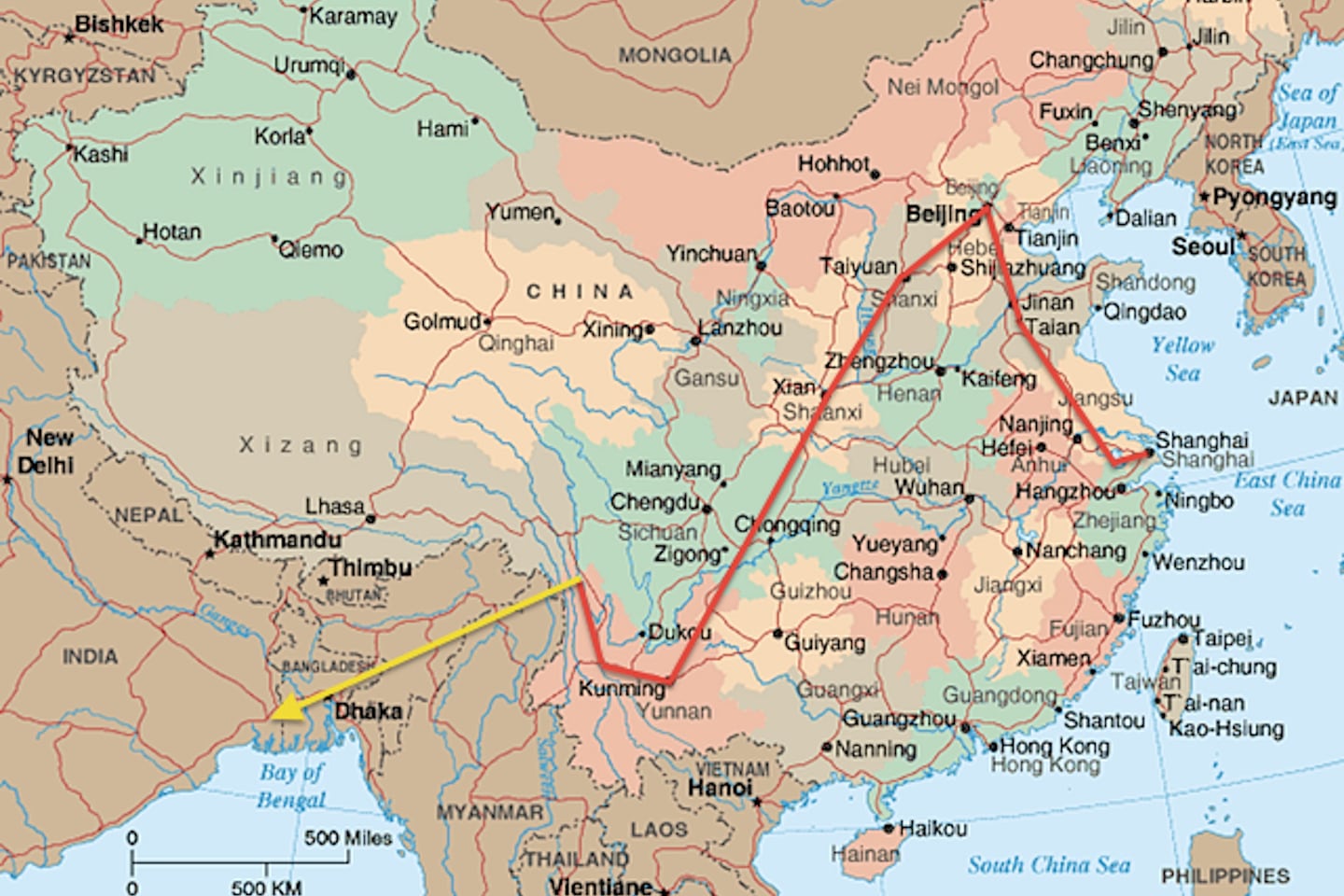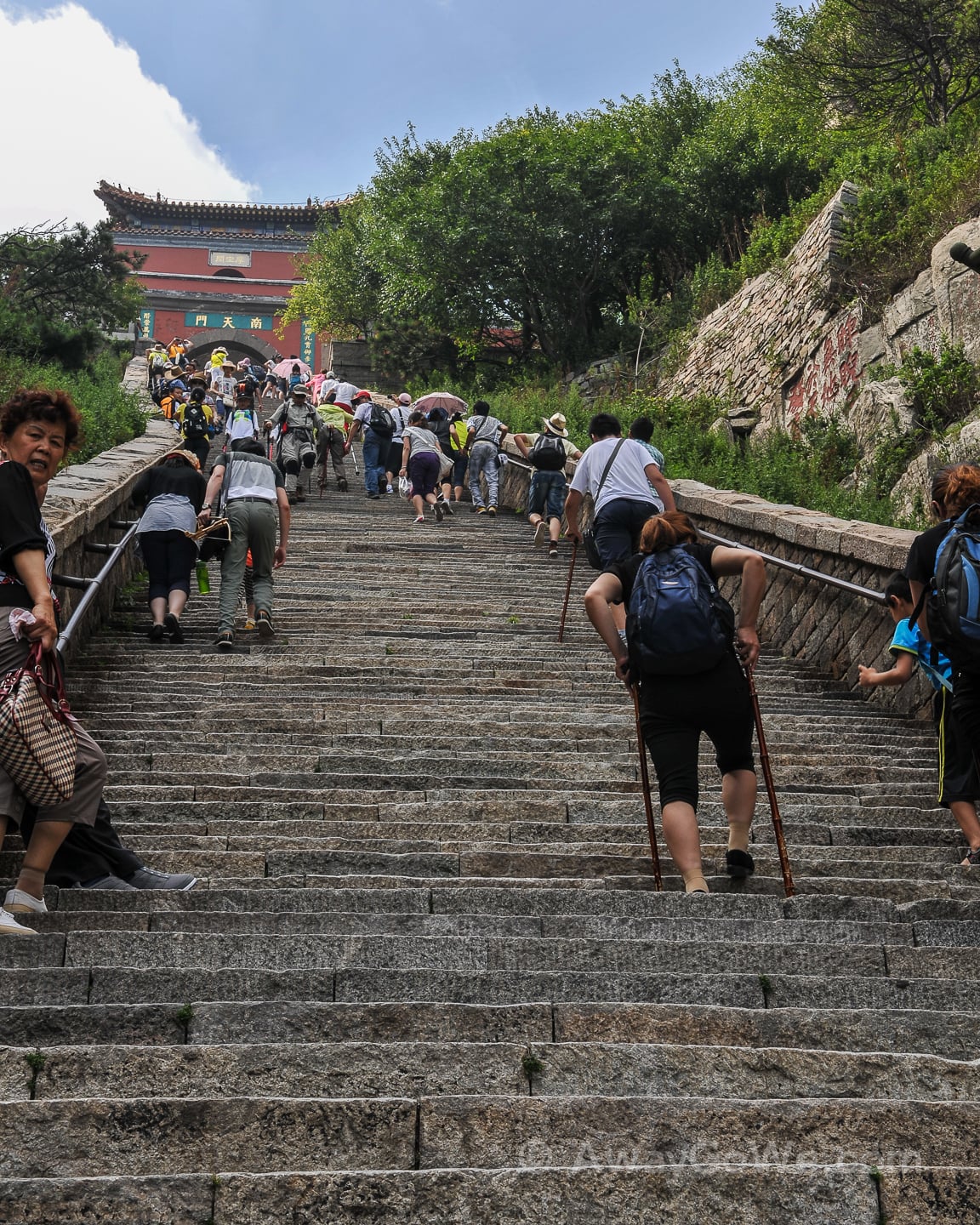
Our Tai Shan Trip Report
Despite reading up on climbing Tai Shan it never was clear what we were in for. We basically knew two things: The process of climbing the mountain involves ascending over 6,600 individual stair steps, and Taishan is very, very popular with Chinese. These two facts alone might repel many foreign tourists perhaps (and indeed we only saw three non-Asian climbers during our entire two day journey), but Lori and I were excited to take on the challenge and see what all the fuss was about.
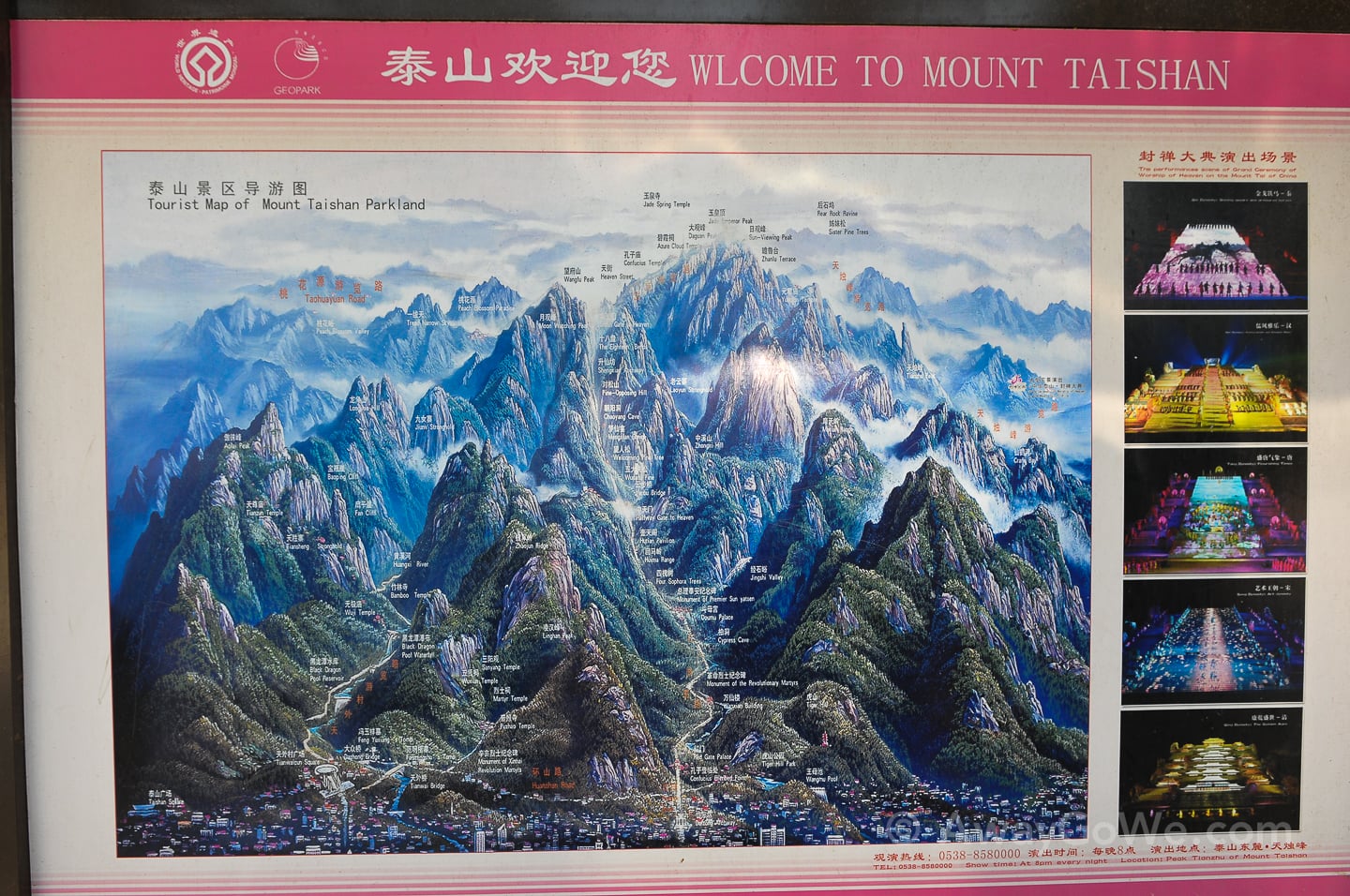
A little background on Tai Shan (Tai=Peace/Peaceful; Shan=Mountain) from wikipedia:
Mount Tai (Chinese: 泰山; pinyin: Tài Shān) is a mountain of historical and cultural significance located north of the city of Tai’an, in Shandong province, China. The tallest peak is the Jade Emperor Peak (Chinese: 玉皇顶; pinyin: Yùhuáng Dǐng), which is commonly reported as 1,545 metres (5,069 ft) tall, but is described by the PRC government as 1,532.7 metres (5,029 ft).
Mount Tai is one of the “Five Great Mountains”. It is associated with sunrise, birth, and renewal, and is often regarded the foremost of the five. Mount Tai has been a place of worship for at least 3,000 years and served as one of the most important ceremonial centers of China during large portions of this period.
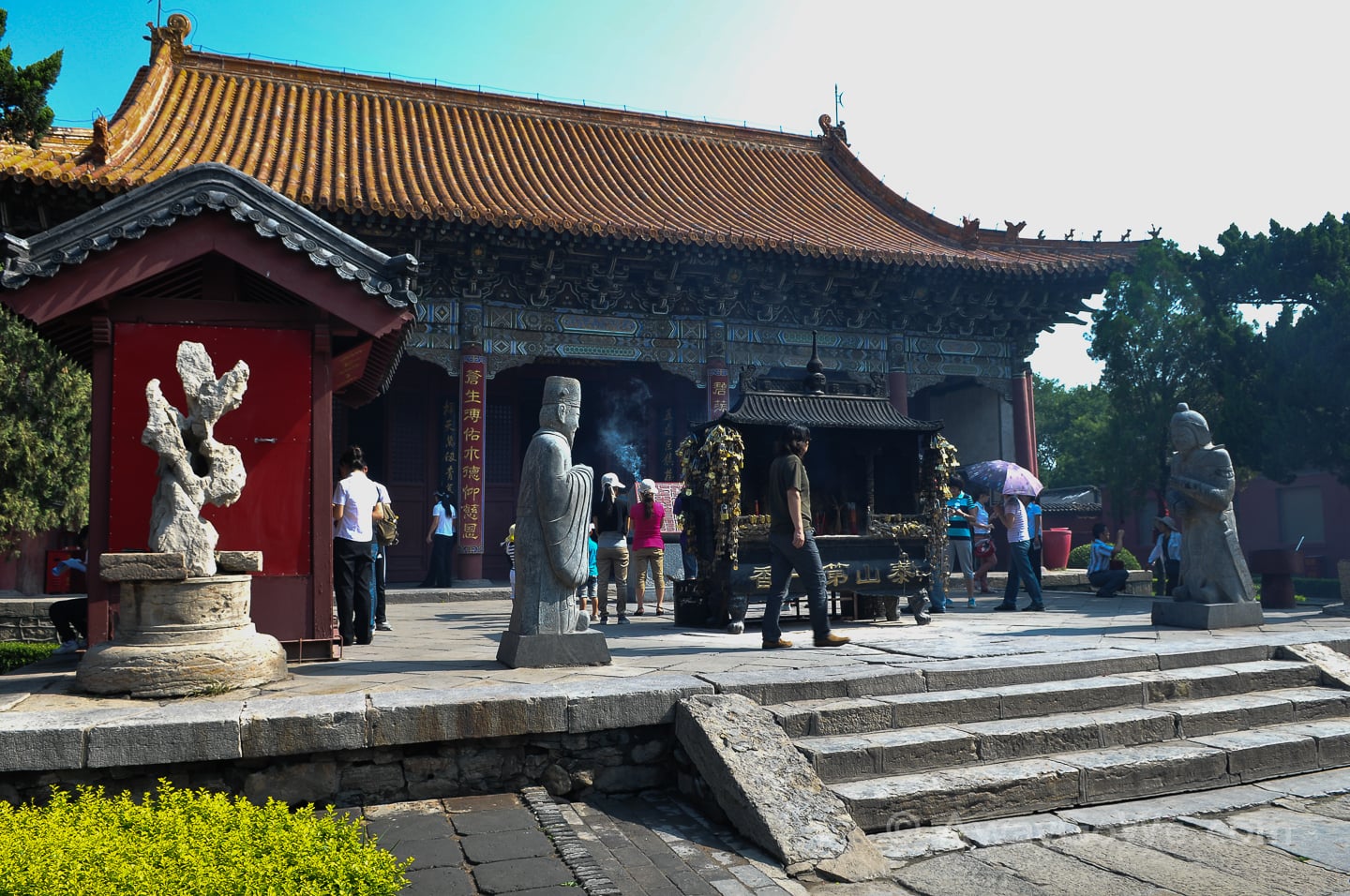
The night before the hike, we stayed in Tai’an, the sprawling city at the foot of the mountain (also often referred to as Taishan). There are a number of hotels and guesthouses in Tai’an, but they appear to cater mostly (if not exclusively) to the throngs of Chinese tourists which visit the mountain daily. All of our online and guidebook resources seem to indicate that only one foreigner-backpacker-oriented place exists in the city which is a very basic HI hostel and a bit of a challenge to find, even though it’s located only steps away from the most well-known temple complex in town (Taishan International Youth Hostel review coming soon).
An overnight stay in Tai’an may not even be necessary if you’re pressed for time, given that the mountain appears to be open very early if not 24/7. Three young Chinese guys at our hostel woke up around midnight to begin their journey up the mountain in time to watch the sunrise from the top. We awoke early on the morning we slept atop the mountain to also watch the sunrise, joining hundreds of others for the event. In fact, watching the sun rise atop Taishan seems to be the main attraction and even principle purpose for the long slog up the mountain in the first place.
Contrary to what is written in Lonely Planet, there are NOT a large number of budget accommodation (or of any price) on the summit as we only came across a grand total of two hotels and two informal budget guesthouses. Perhaps for Mandarin speakers, this number quadruples. But for intrepid English speakers, we were quite lucky to find even four as they are not clearly advertised in pinyin. It is important to note, perhaps, that this endeavor (like so many tourist sights and experiences in China) is not targeted to foreign tourists in the least, so don’t expect to see much of anything written in English, French, or whathaveyou, and certainly don’t expect a soul to speak anything other than Mandarin or other Chinese dialect.
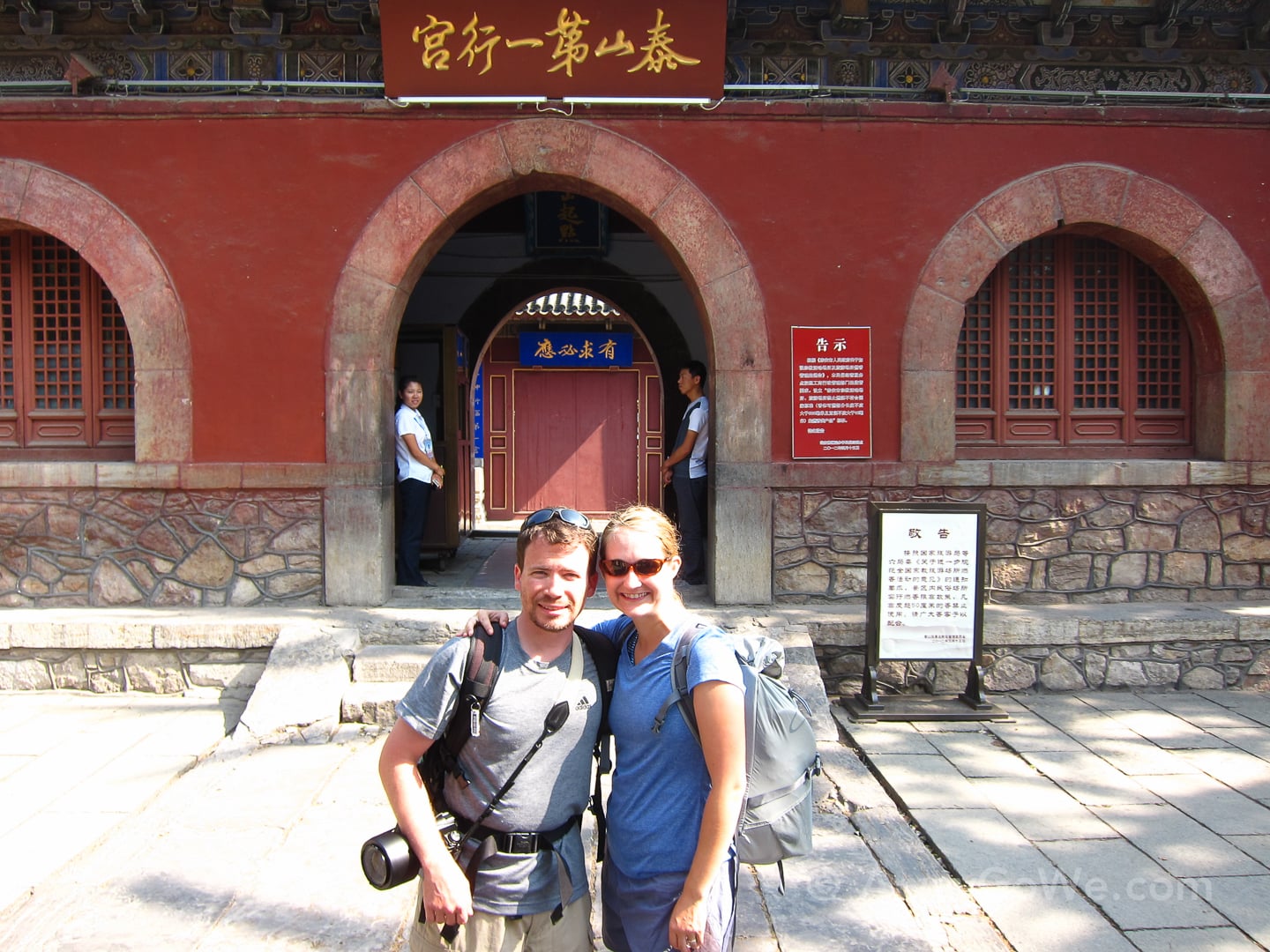
Dai Temple
There are a variety of ways to ascend Taishan: on foot, foot/cable car, bus/foot, bus/ cable car. However, the most devout pilgrims (and craziest climbers) start about a mile south of the main ticket office at the Dai Temple. This is where Lori and I started our long slog up the mountain.
More about the Dai Temple (from wikipedia):
The Temple of the God of Mount Tai, known as the Dai Temple (Chinese: 岱庙; pinyin: Dàimiào), is the largest and most complete ancient building complex in the area. It is located at the foot of Mount Tai in the city of Tai’an and covers an area of 96,000 square meters.
The temple was first built during the Qin Dynasty. Since the time of the Han Dynasty (206 BC – 220 AD), its design has been a replica of the imperial palace, which makes it one out of three extant structures in China with the features of an imperial palace (the other two are the Forbidden City and the Confucius Temple in Qufu).
The temple has five major halls and many small buildings. The centerpiece is the Palace of Heavenly Blessings (Tian Kuang), built in 1008, during the reign of the last Northern Song Emperor Huizong.
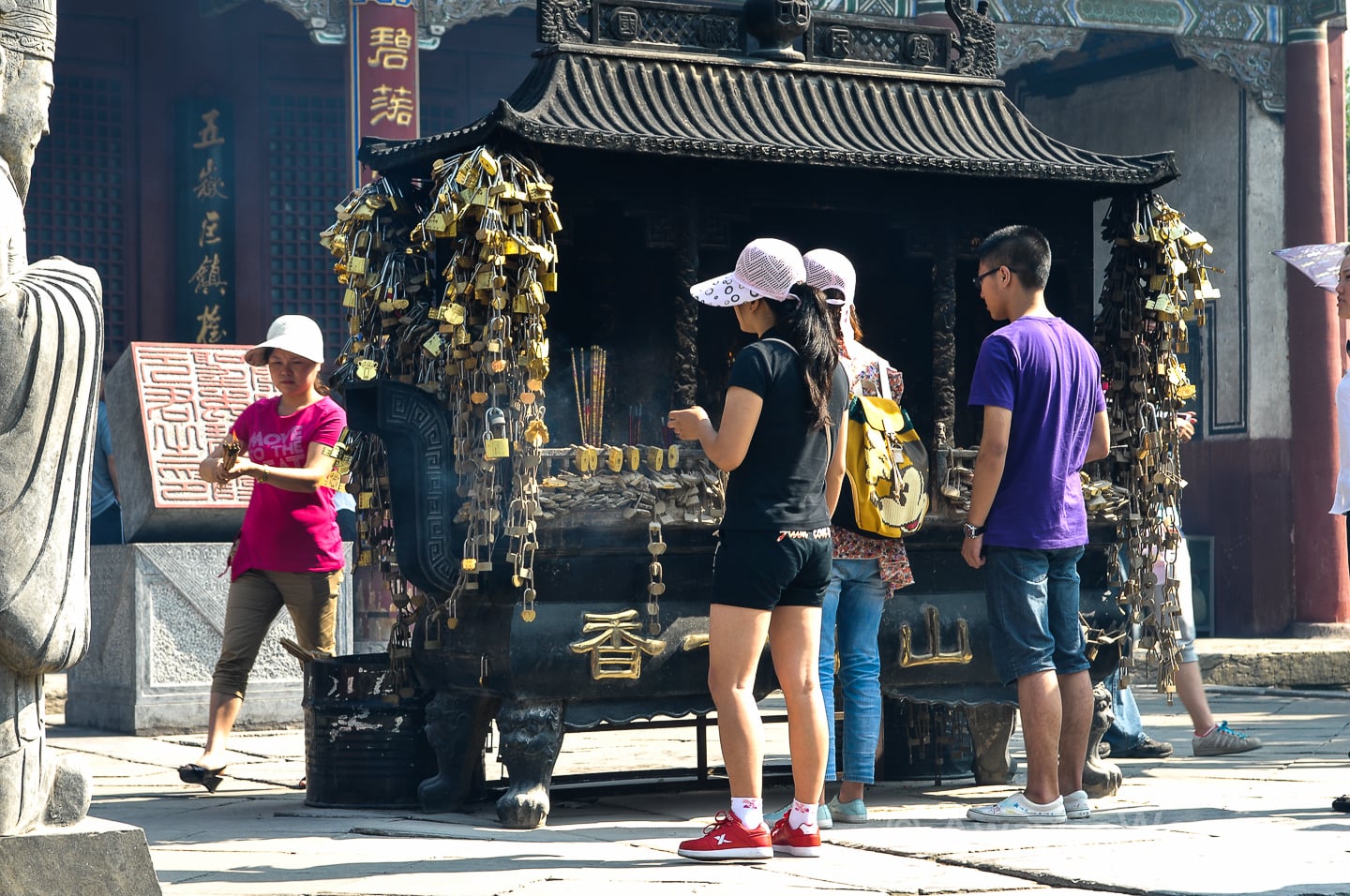
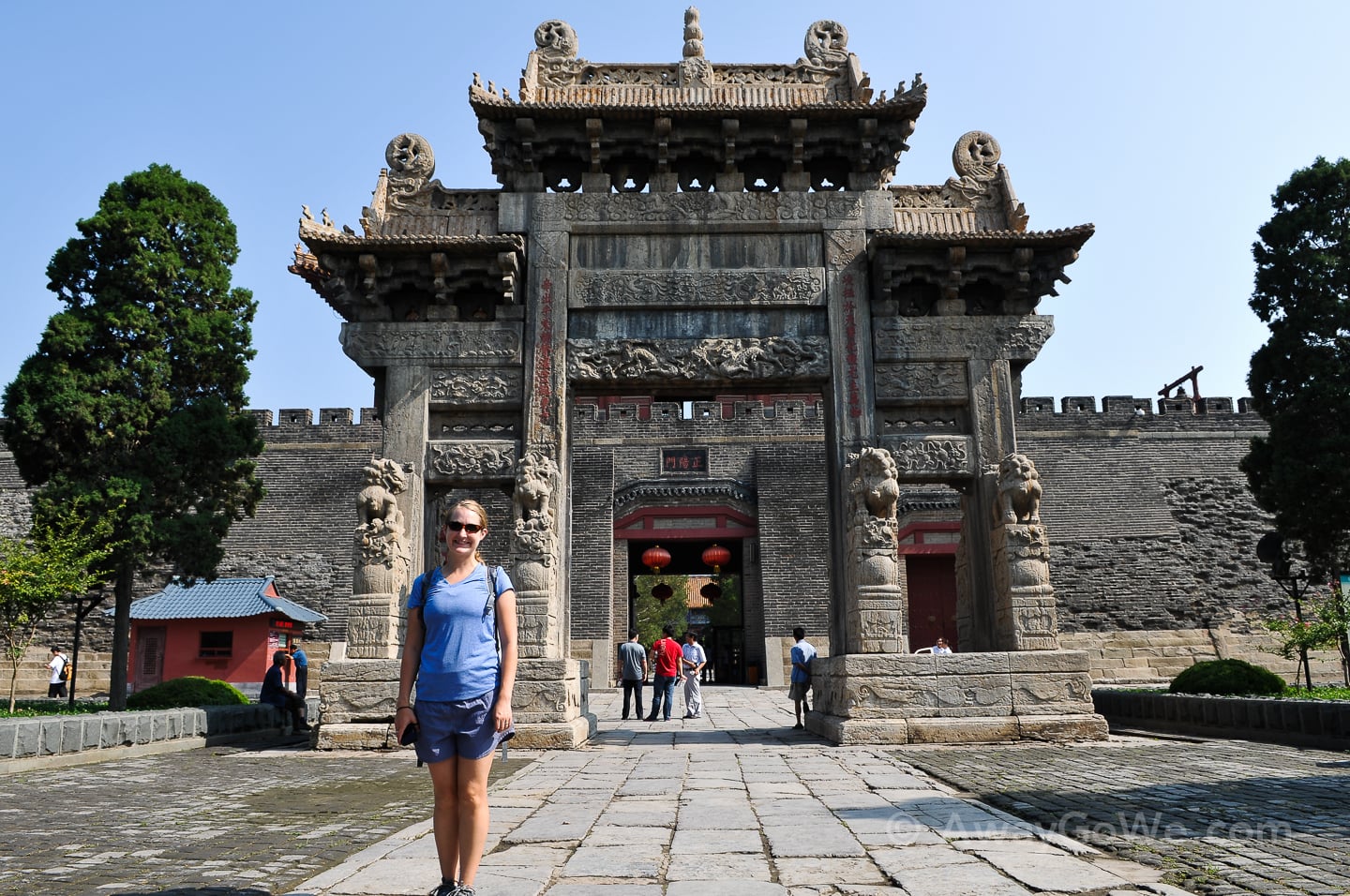
The temple is a sprawling complex worth seeing and a great place to get focused on the mountain. The north ramparts even offer a superb view of the mountain from which to fix your gaze and get oriented (and psyched). The temple does cost a small fee to enter.
If you are staying at Taishan International Youth Hostel, head out to the main (front) road, take a left, and walk north to the temple. The general orientation of the Taishan trail is from south to north. You can enter the temple at the south gate and exit through the north. From there, follow the main road to its terminus (about a mile north); you’ll know you’ve arrived when you see the taxis and buses and hoards of Chinese tourists. Alternatively, you can take the bus from about a block away from the hostel.
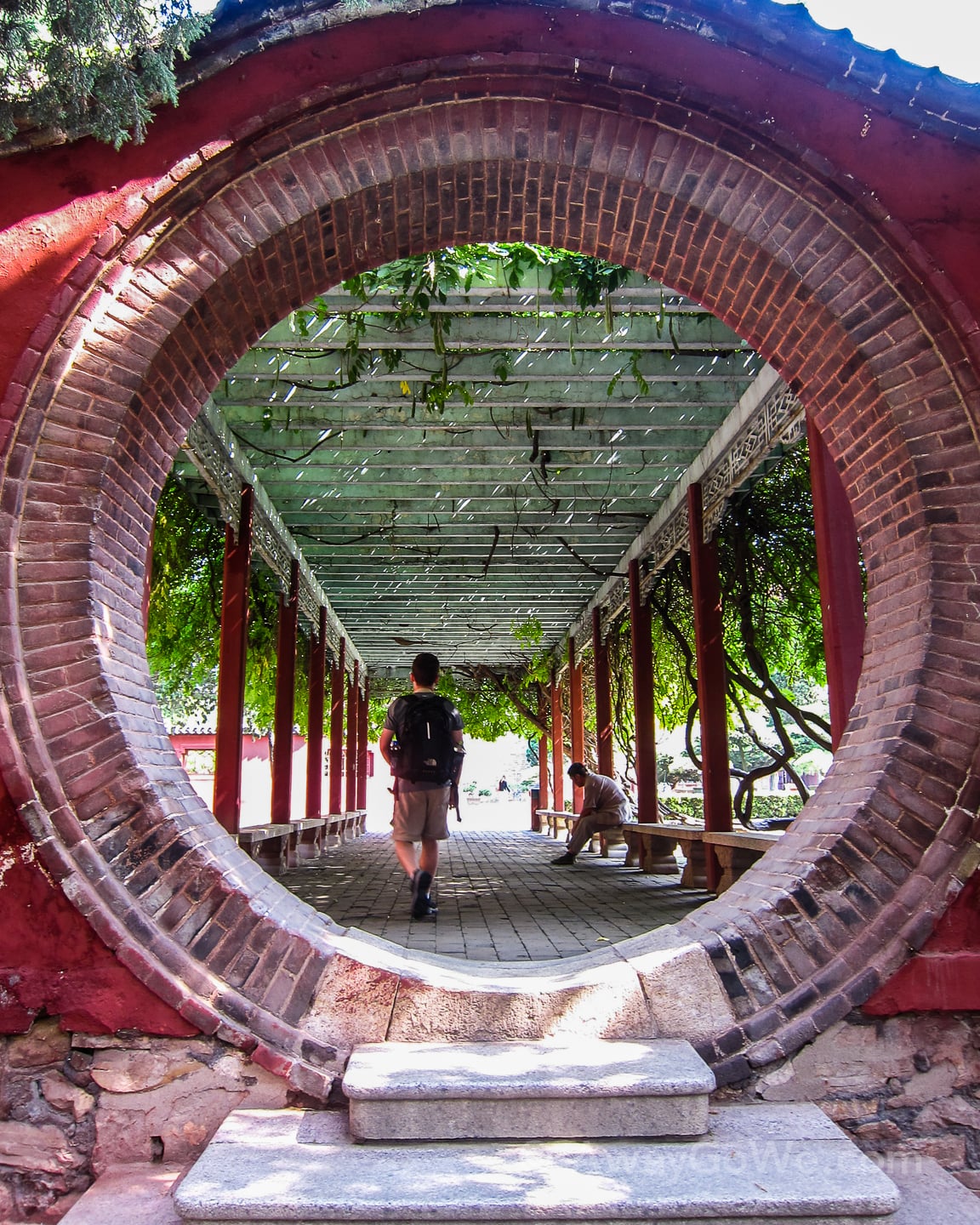
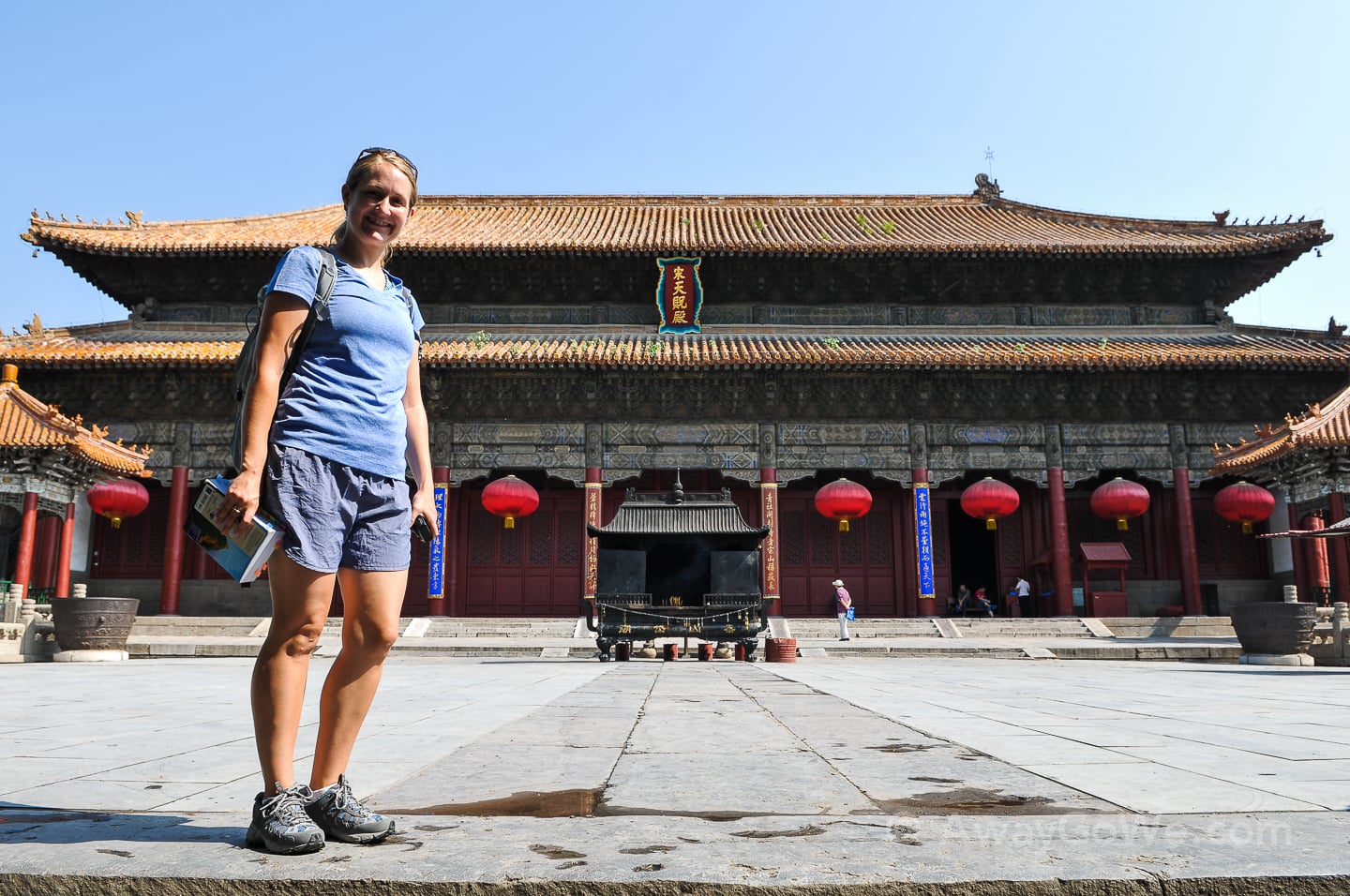
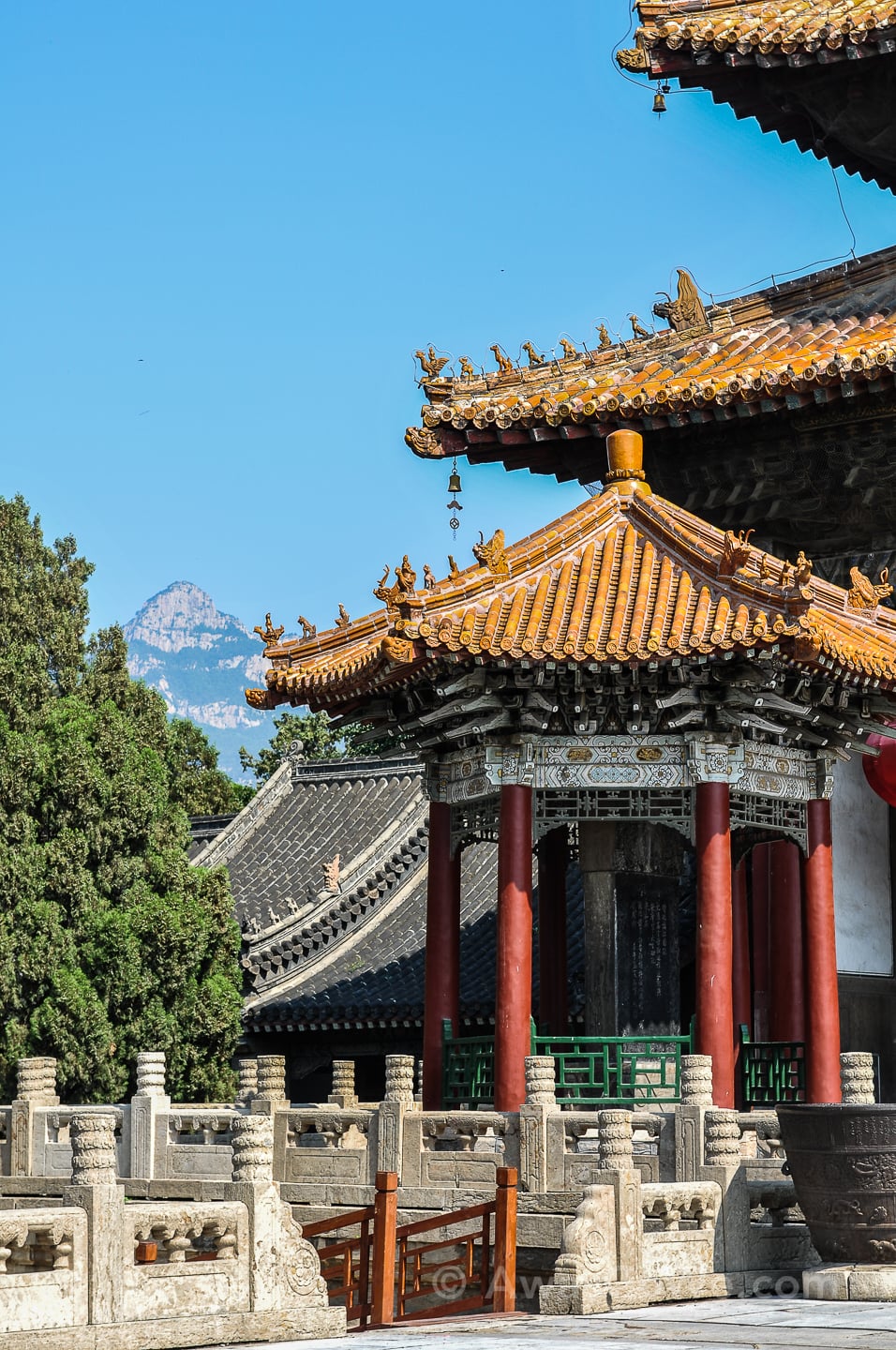
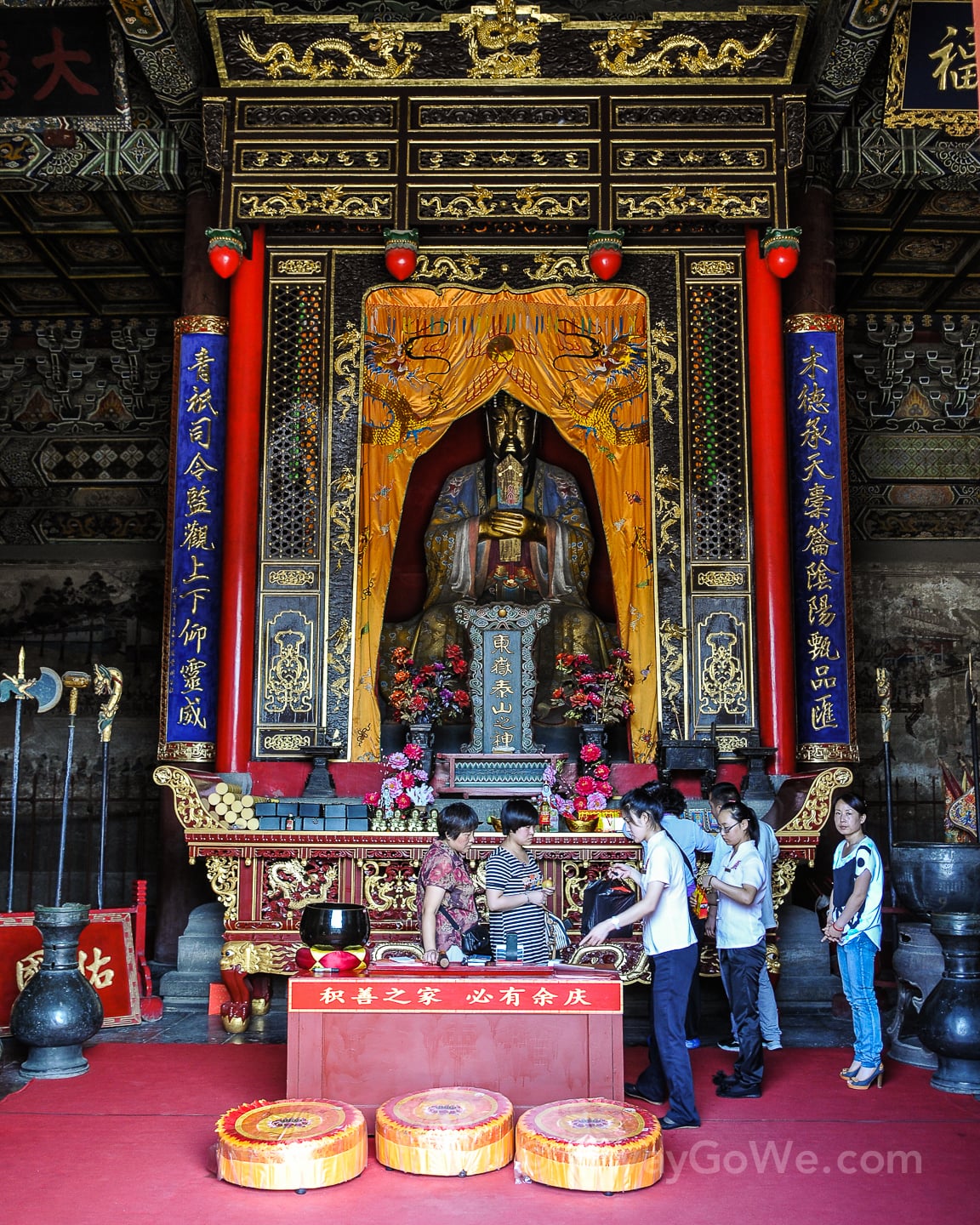
Climber’s Breakfast
This might be a good time to talk breakfast. You’re going to need a good, hearty breakfast to start your journey given that there aren’t many places along the way to get a proper meal before the summit.

At the time of writing, the hostel had two choices: American breakfast and English breakfast (same as the American, but adds a tomato… for the same price). Lori and I chose this option because it was easiest, but we didn’t find the breakfast terribly filling, or tasty, or that cheap. In retrospect, a better option might have been grabbing breakfast at the McDonald’s (one block north and about two large blocks west of the hostel). If you’re looking for powerfood for mountain climbing, you’re just going to have to bring your own muesli, porridge, oatmeal, fruit and yogurt, or whatever the hippies are eating these days (actually that all sounds quite delicious, but quite unrealistic in Tai’an). And of course, if you’re into noodles in the morning, noodles in the evening, noodles at suppertime…there are always noodles (instant and otherwise) to be had.
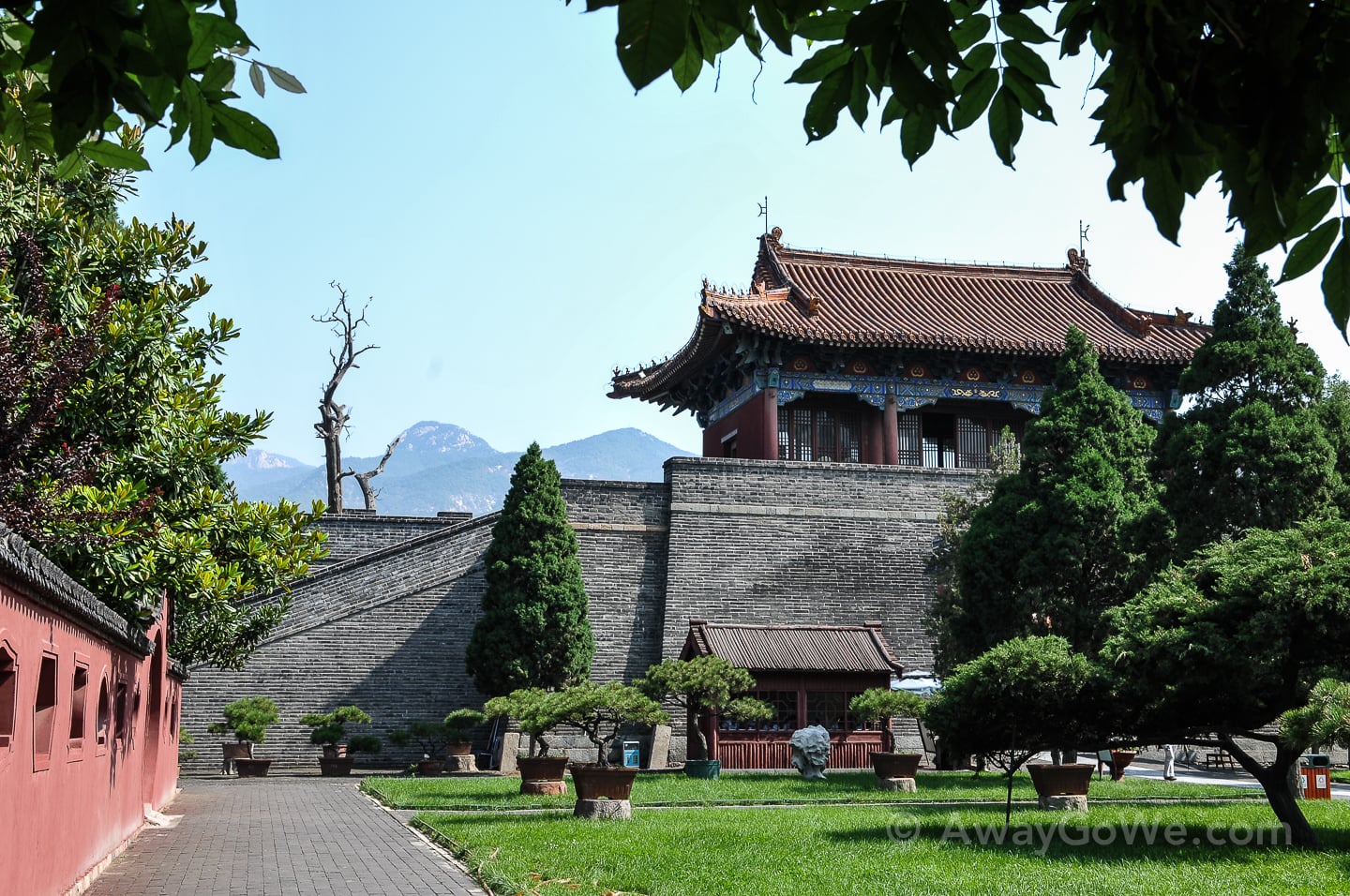
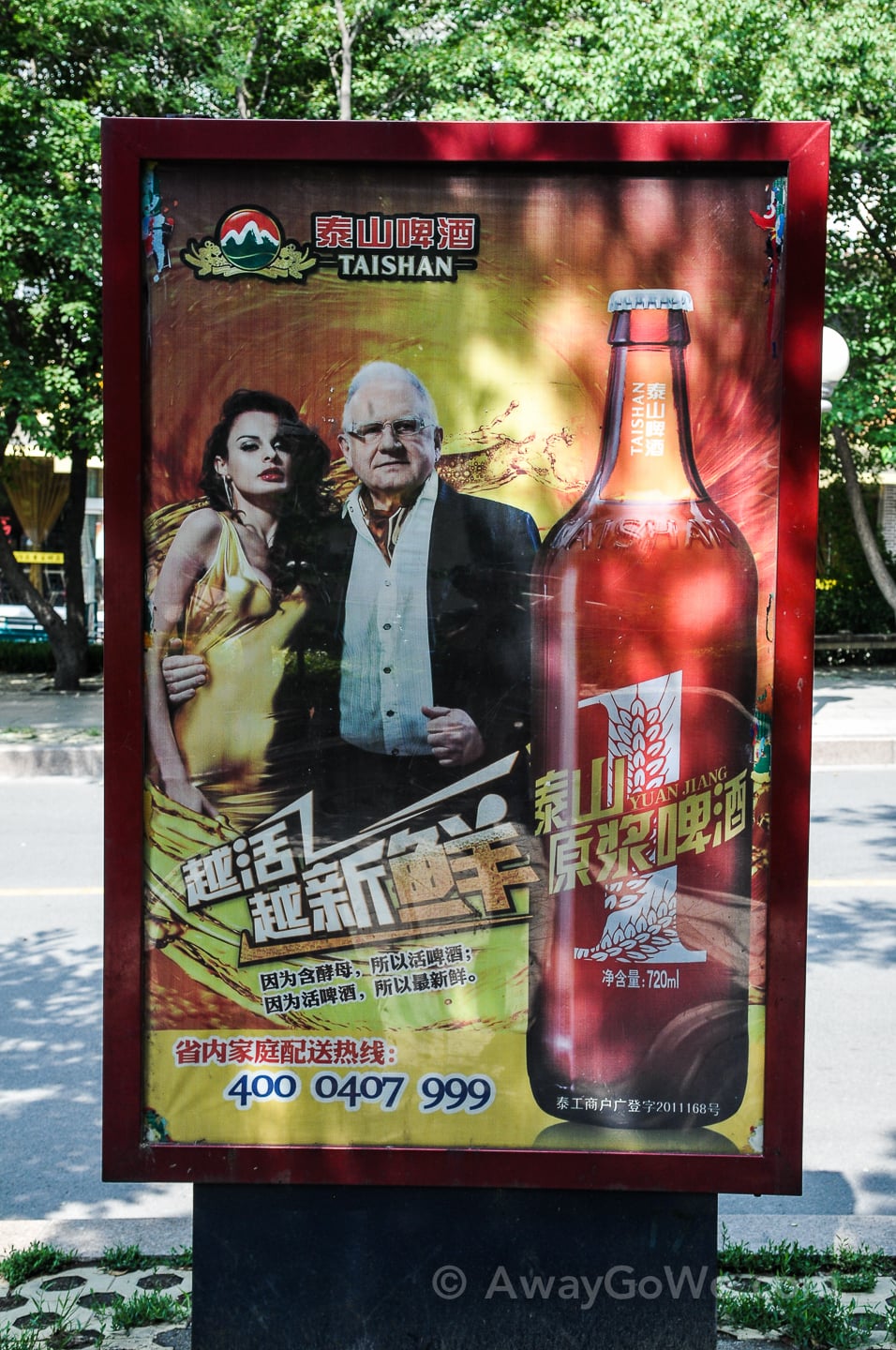
Random advert we passed on our way to the admission gate. Who knows what it’s selling. The “aged” dude’s scarf-around-the-neck is especially great.
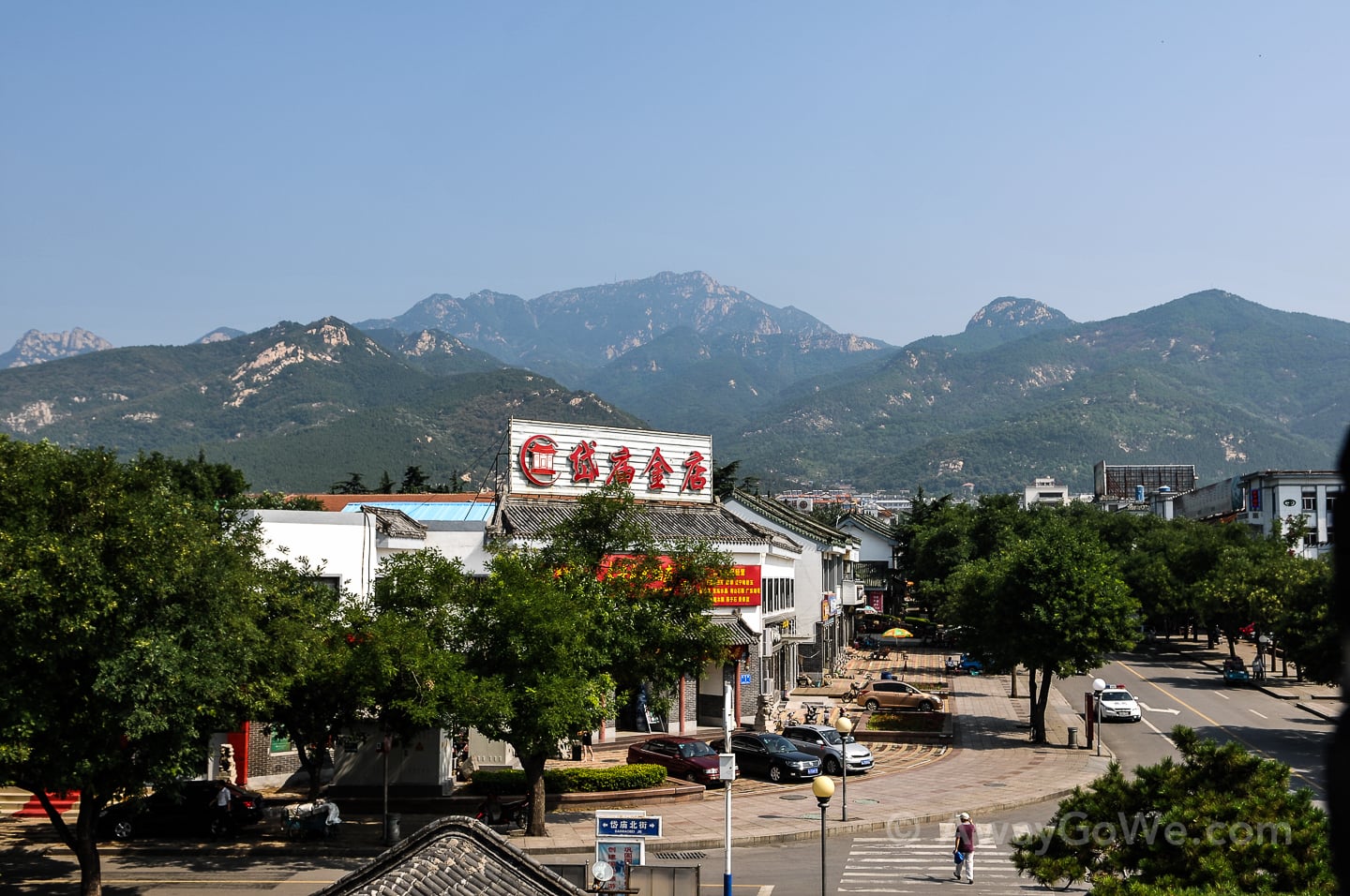
6,600 Steps :: The Climb
From ChinaCulture.com:
Taishan Mountain rises abruptly to 1,300 meters (4,265 feet) above the vast plain of north China. The sharp contrast between Taishan Mountain and its surrounding plain and hills makes it especially majestic.
Taishan Mountain rises from about 150m (492 ft.) above sea level (north of Tai’an City), to the Middle Gate to Heaven at 847m (2,778 ft.), to the Southern Gate to Heaven at 1,460m (4,790 ft.), and finally to the Jade Emperor Peak at 1,545m (5,068 ft.). Standing in the central part of Shandong, the mountain stretches 100 kilometers (60 miles).
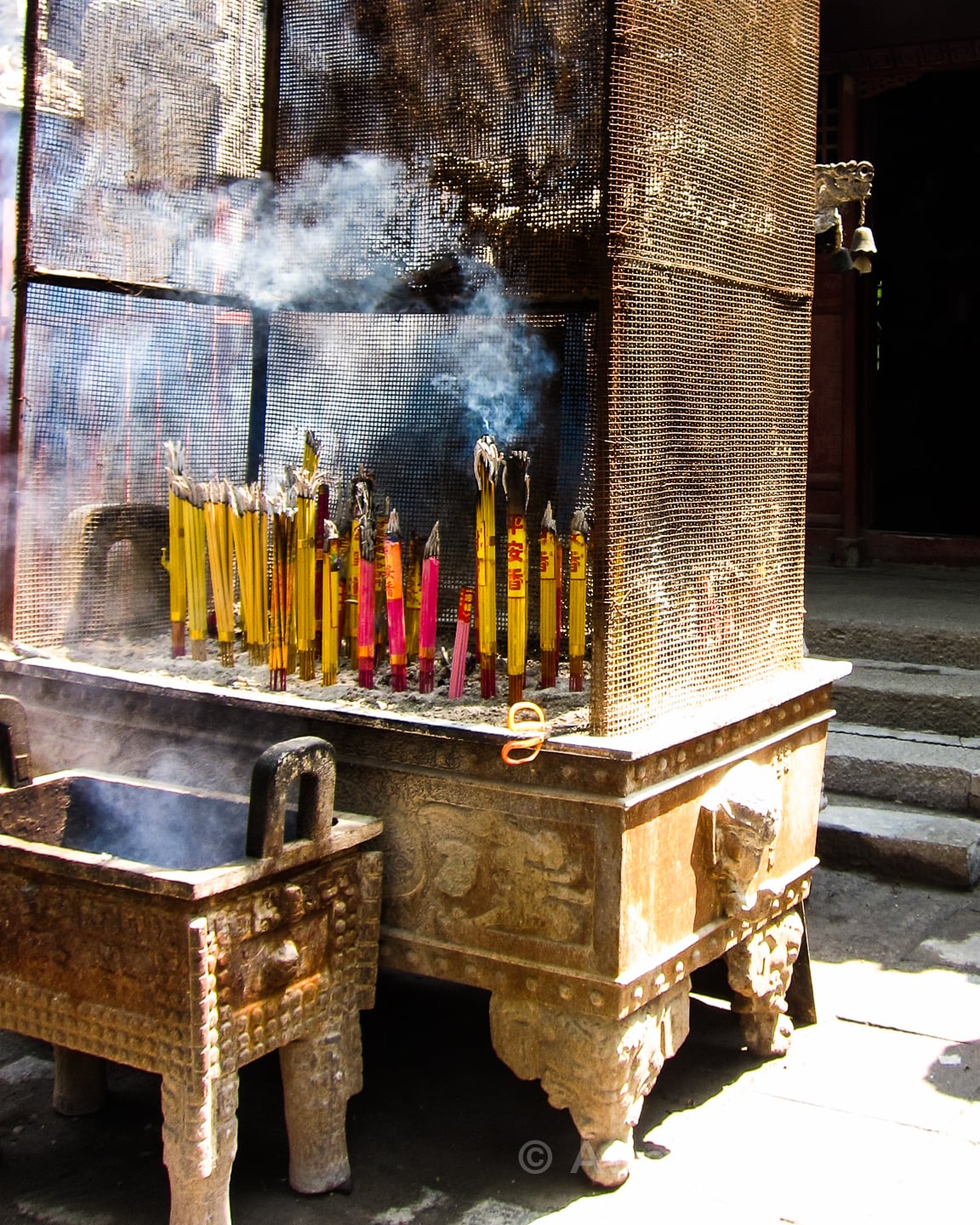
Once you get to the park entrance, it’s about 500m to the ticket office (don’t forget your student ID!). Also, don’t forget to stock up on water. We brought about 2.5L of water and Propel with us. The day we climbed up was a scorcher and we could have easily brought more water. Water, propel, soda and even Red Bull (the Chinese love their Red Bull) can be purchased at regular intervals along the way, but the prices increase as the elevation does.
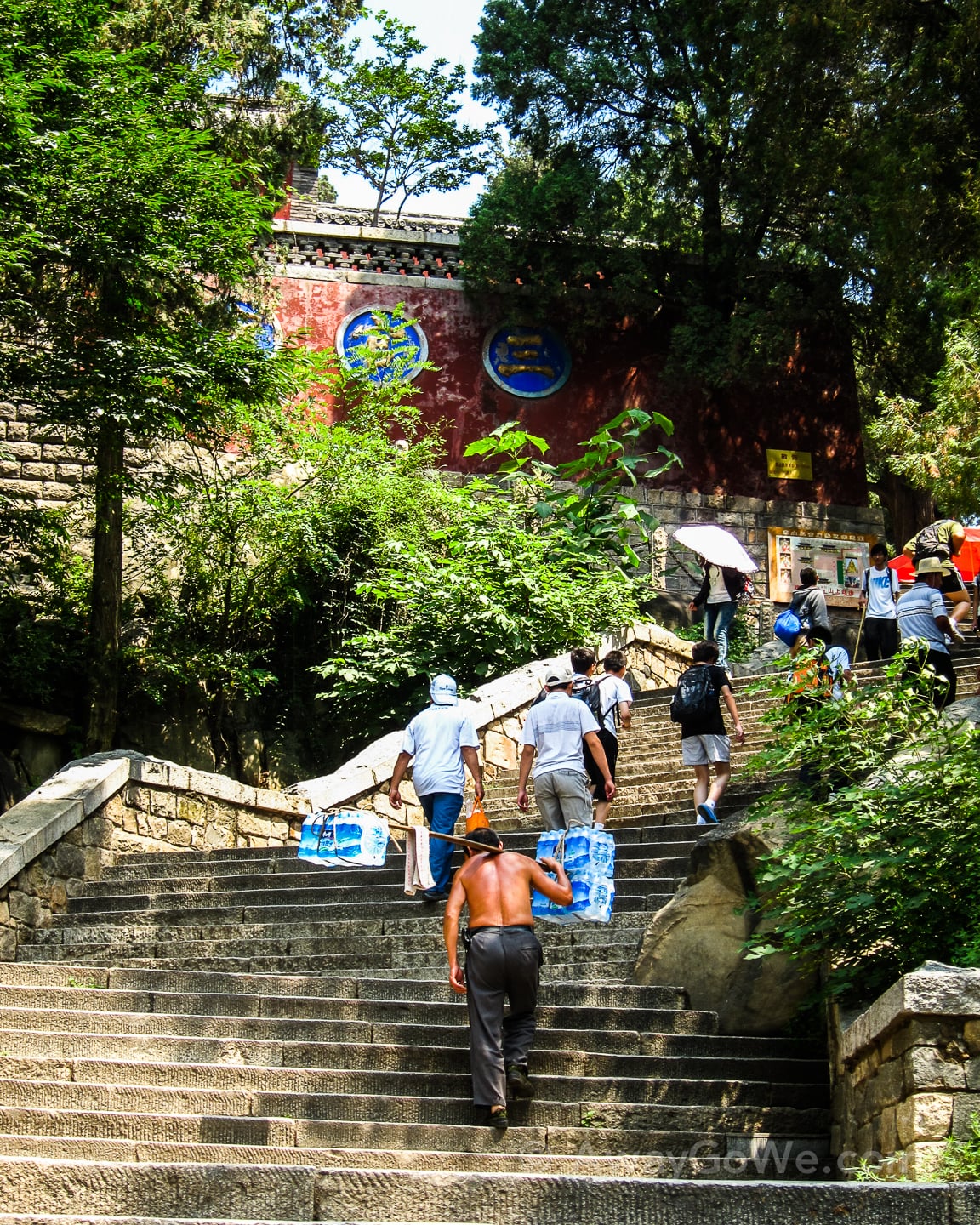
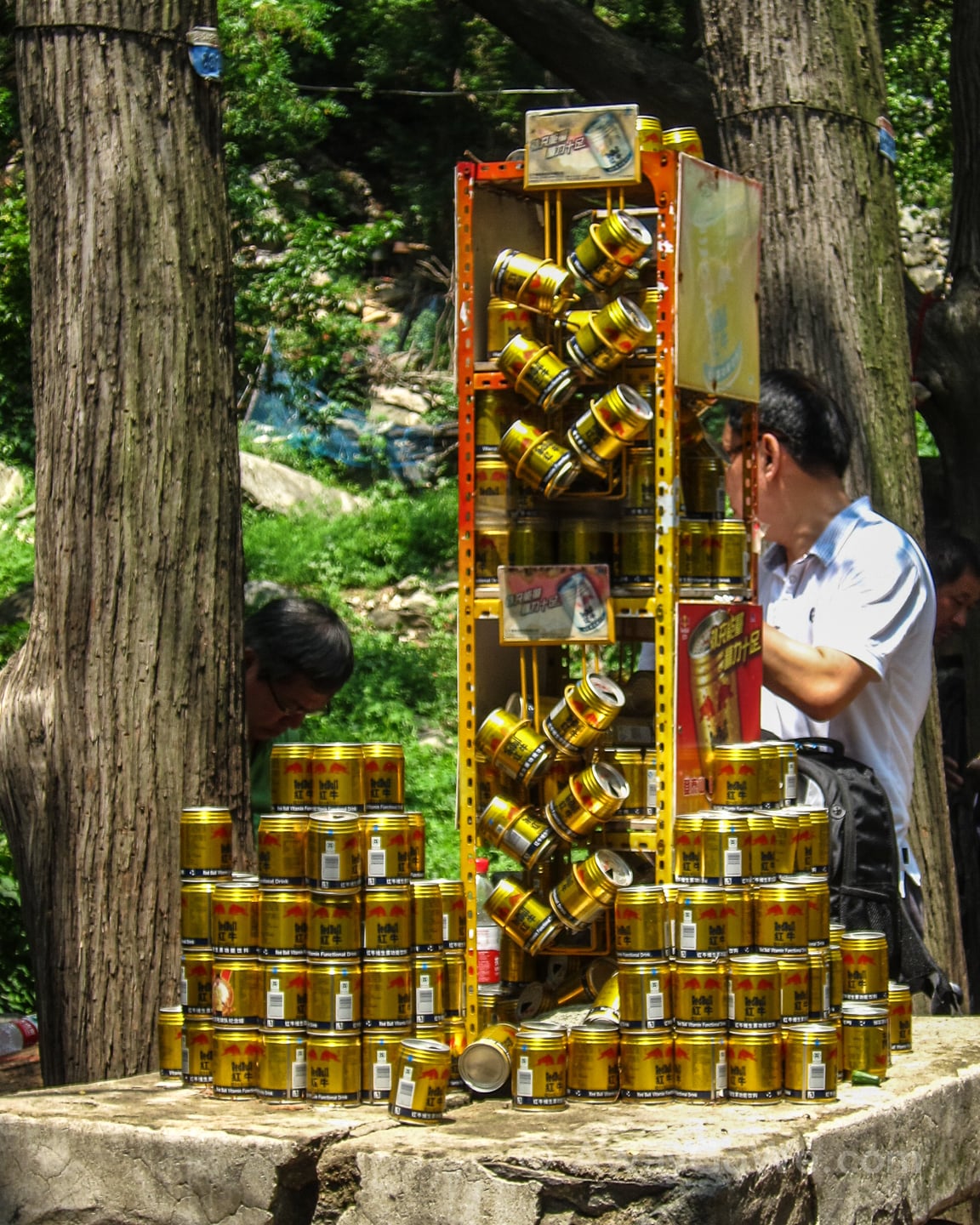
The climb can be done a variety of ways to suit nearly every taste. Heck, to ascend this holiest of mountains one need not climb anything. And indeed it appears that most tourists take a bus to the half-way point, then the cable car the remaining way to the summit. Many also appear to either walk the first half (the easier half) to the cable car station at the half-way point, or take the bus to the half-way point and walk the balance of the hike to the summit. Alternatively, you can hike the whole thing up, then take do the cable car/ bus combo down.
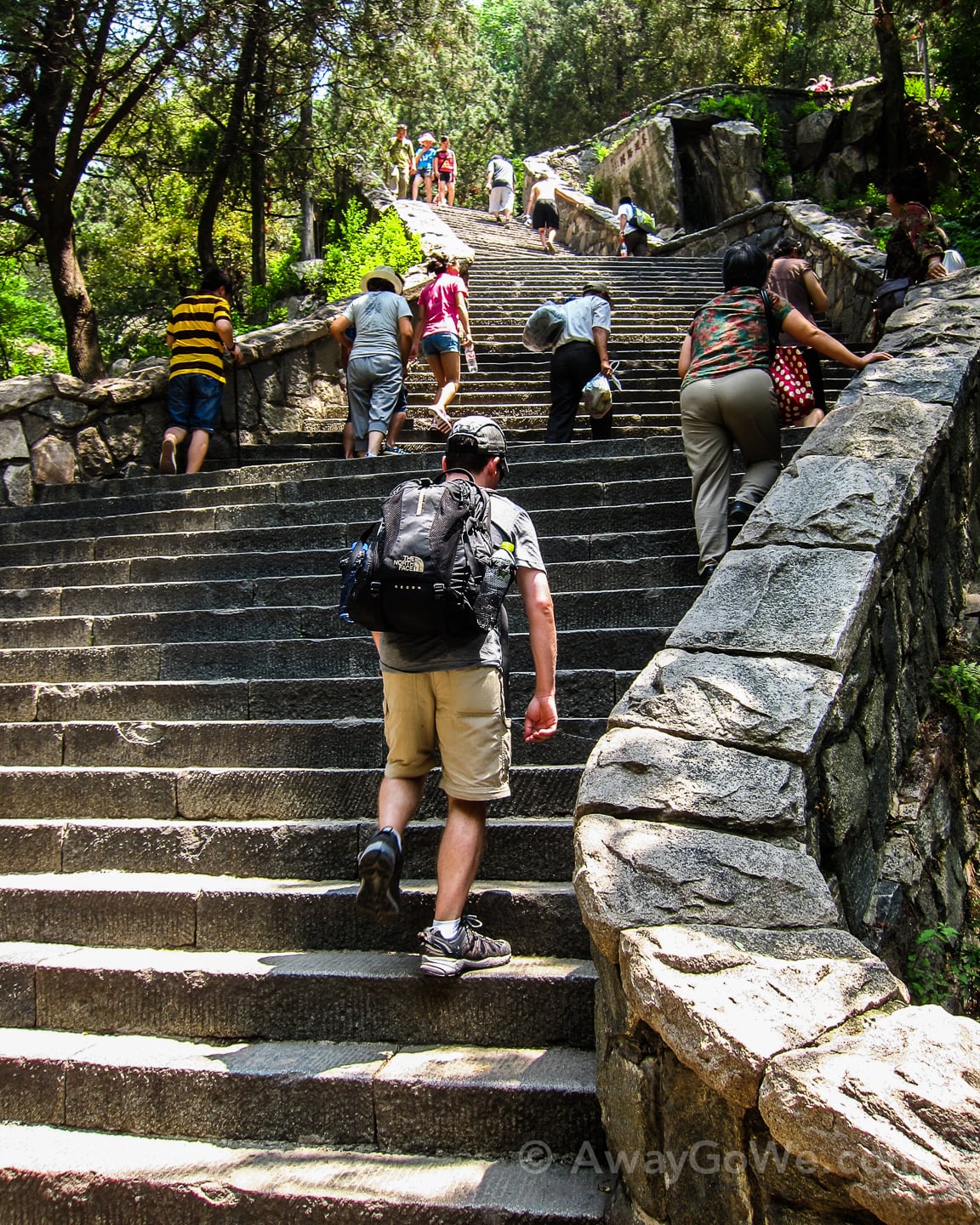
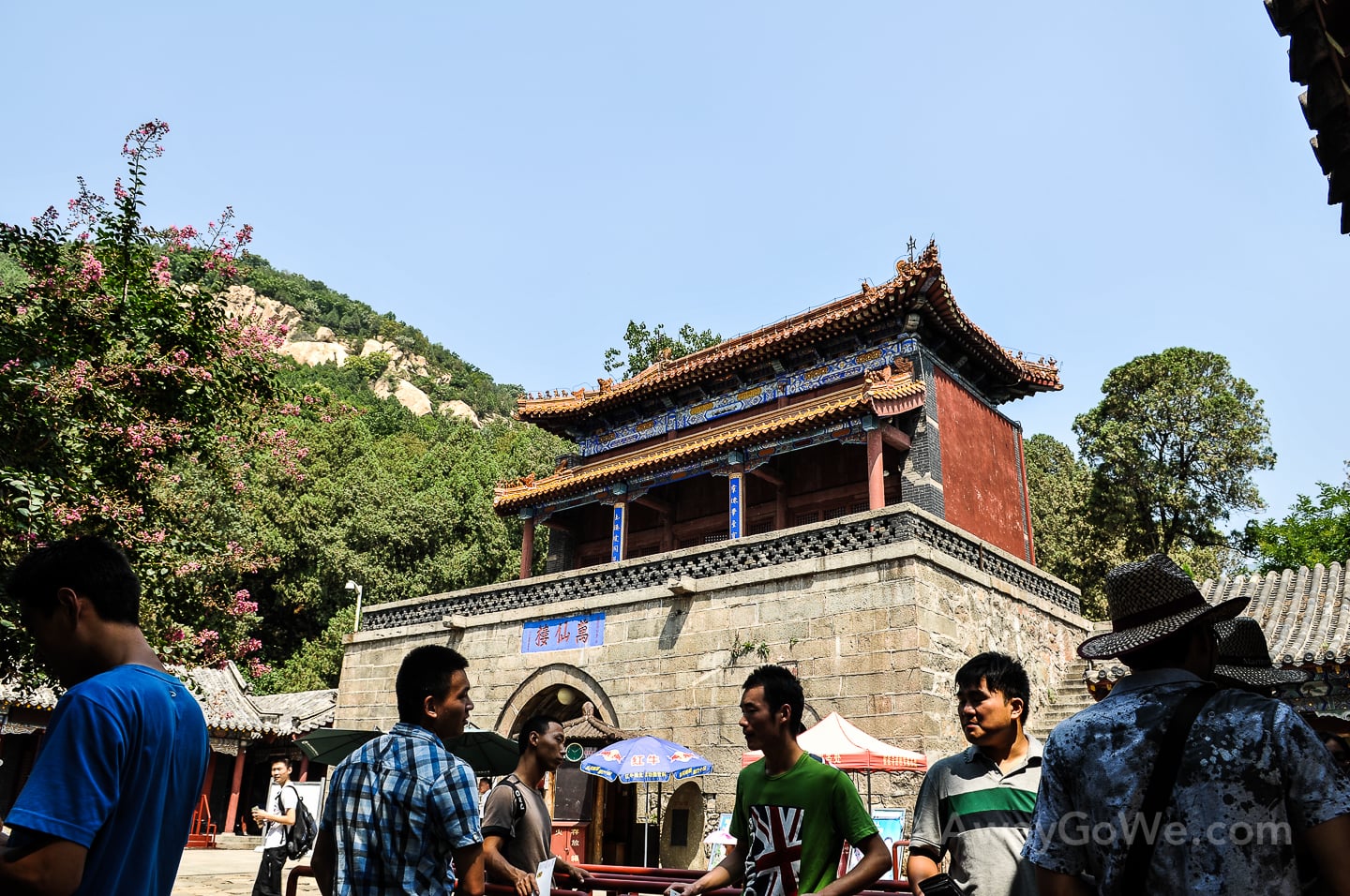
The ascent generally takes 4 hours beginning at the ticket office, stopping only occasionally to catch your breath and get a swig of water. The descent takes about 3. Some choose to do the entire hike in a day (with a couple of hours at the top for resting and sightseeing) while others choose to stay overnight at the top. Lori and I opted for the latter and were quite happy we did.
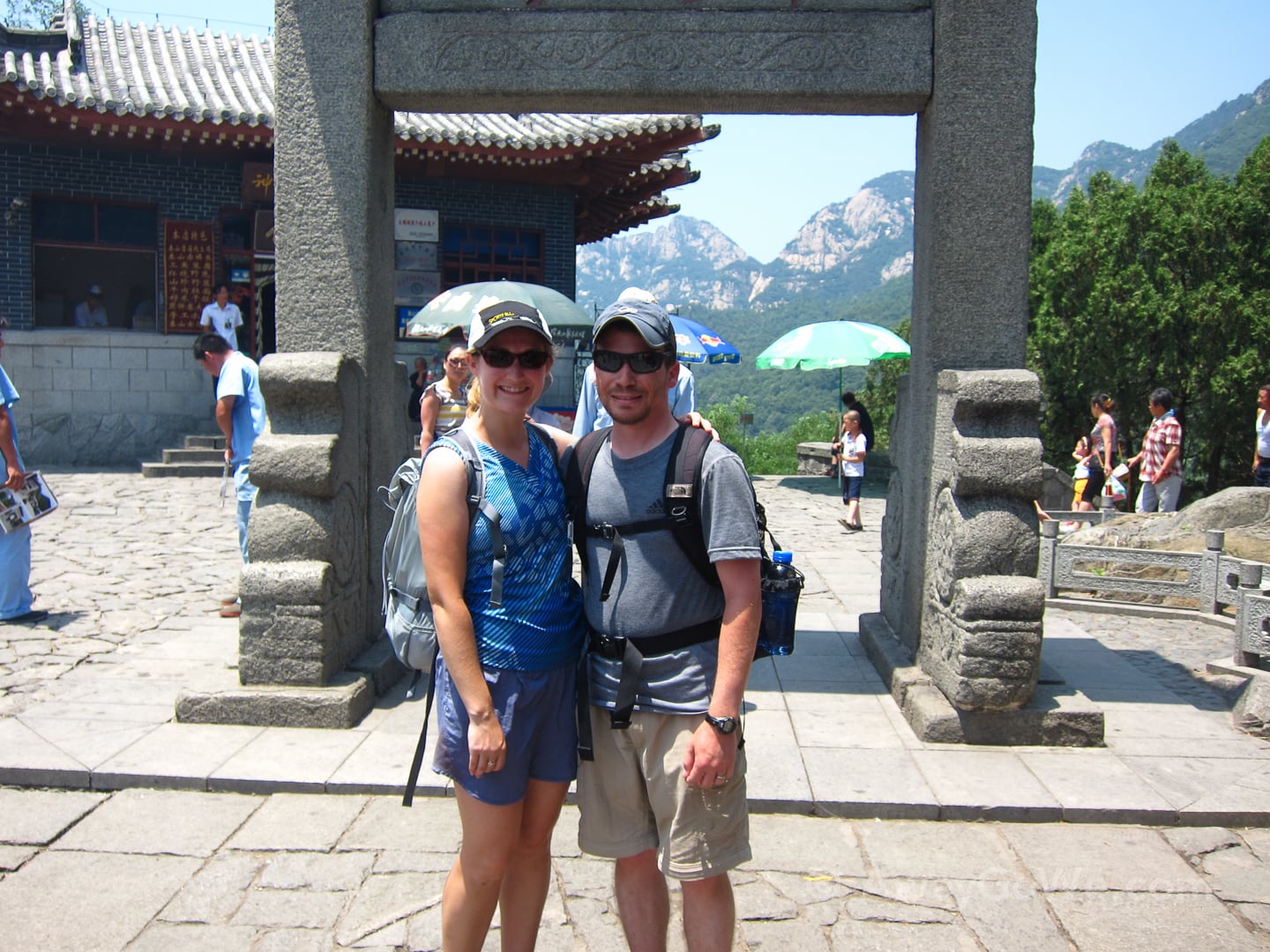
Mid-way Point
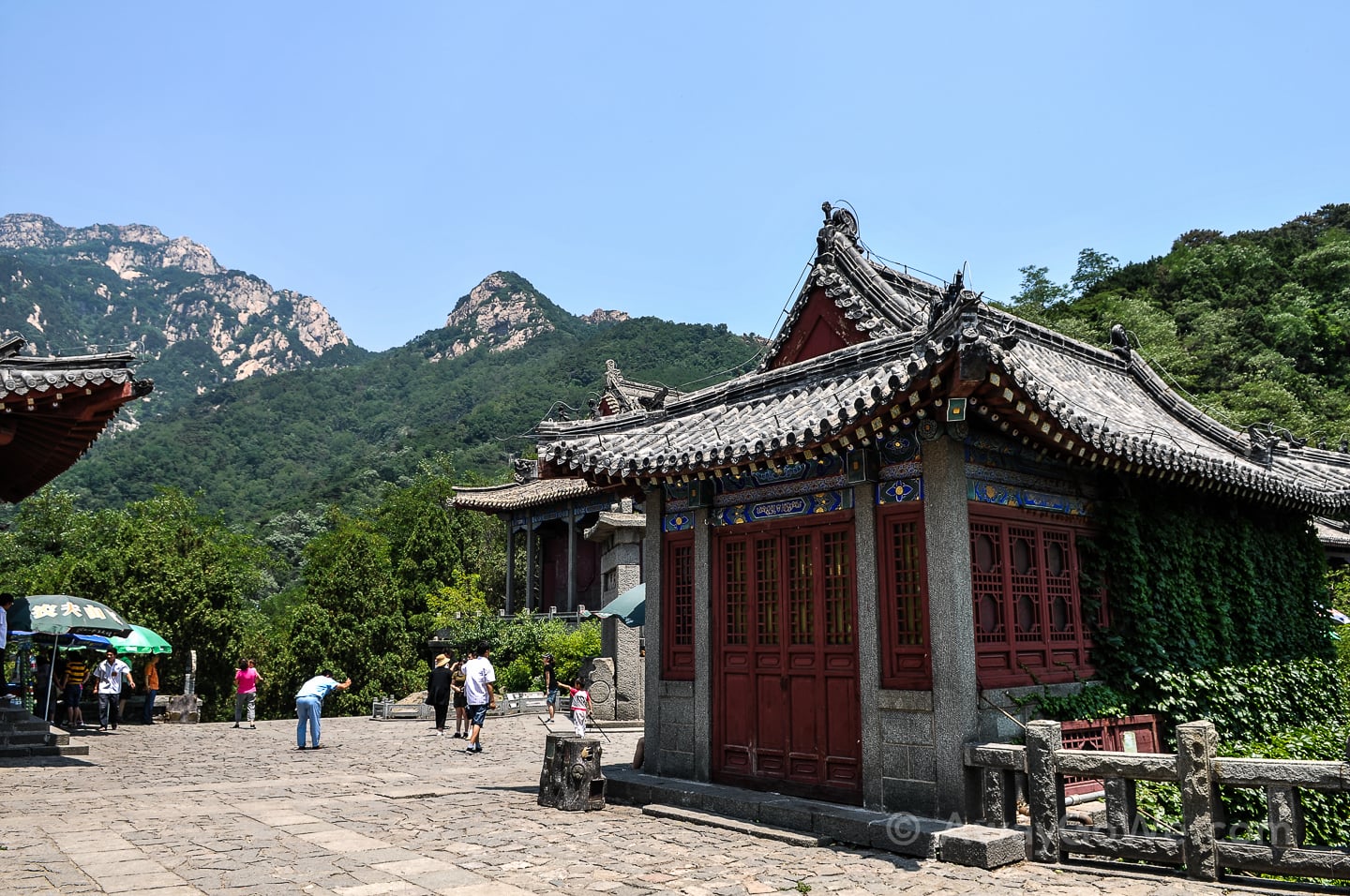
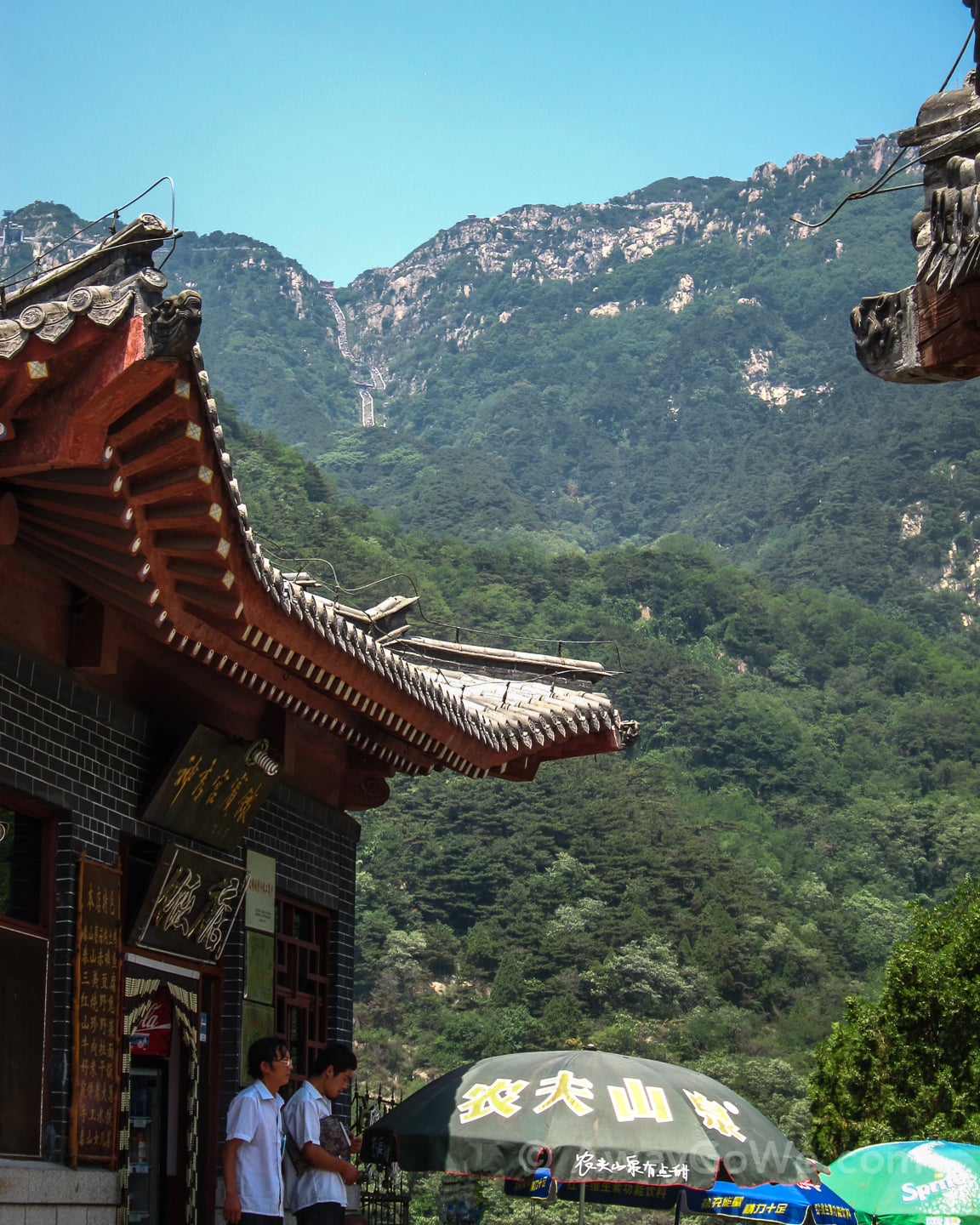
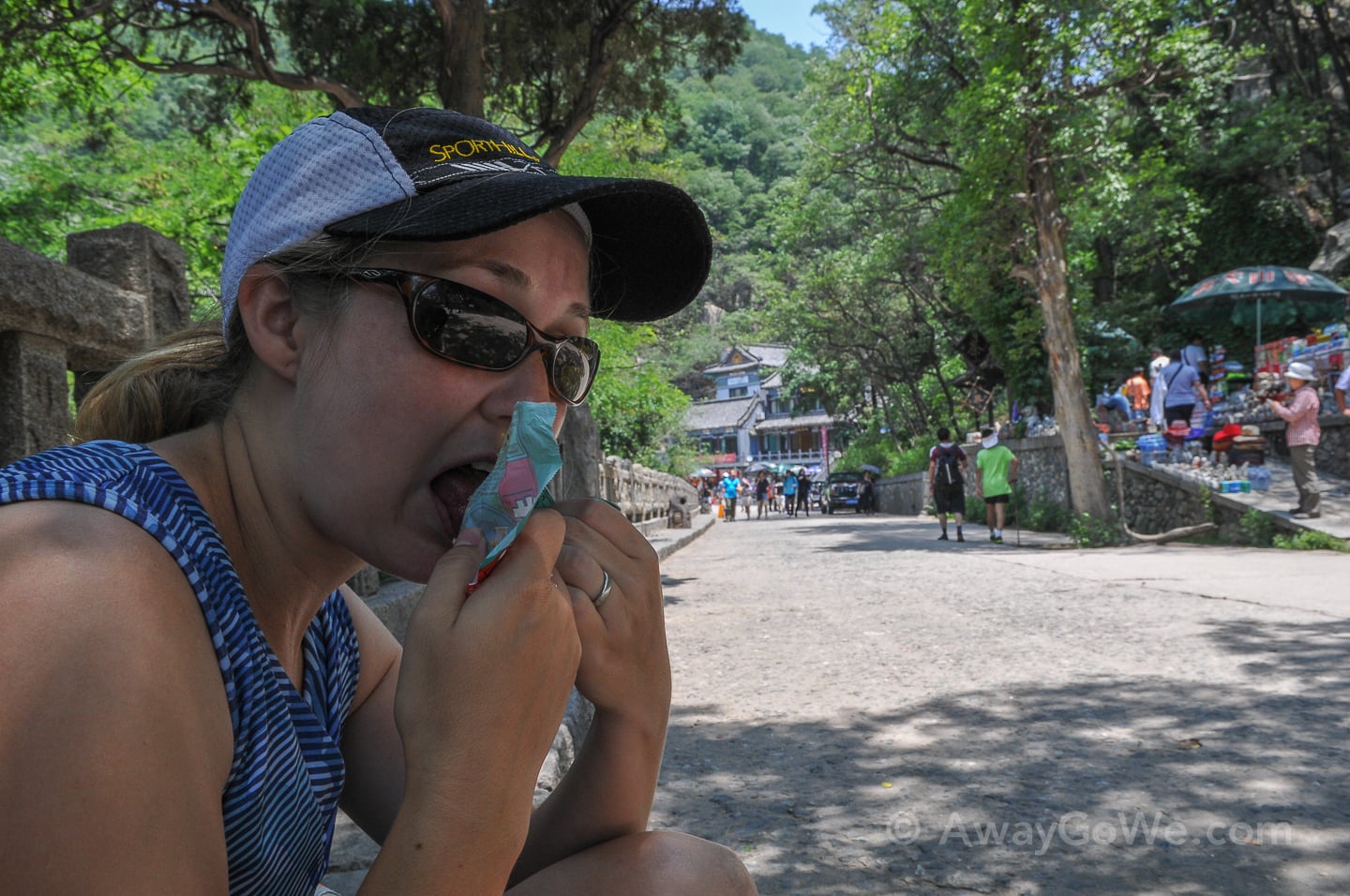
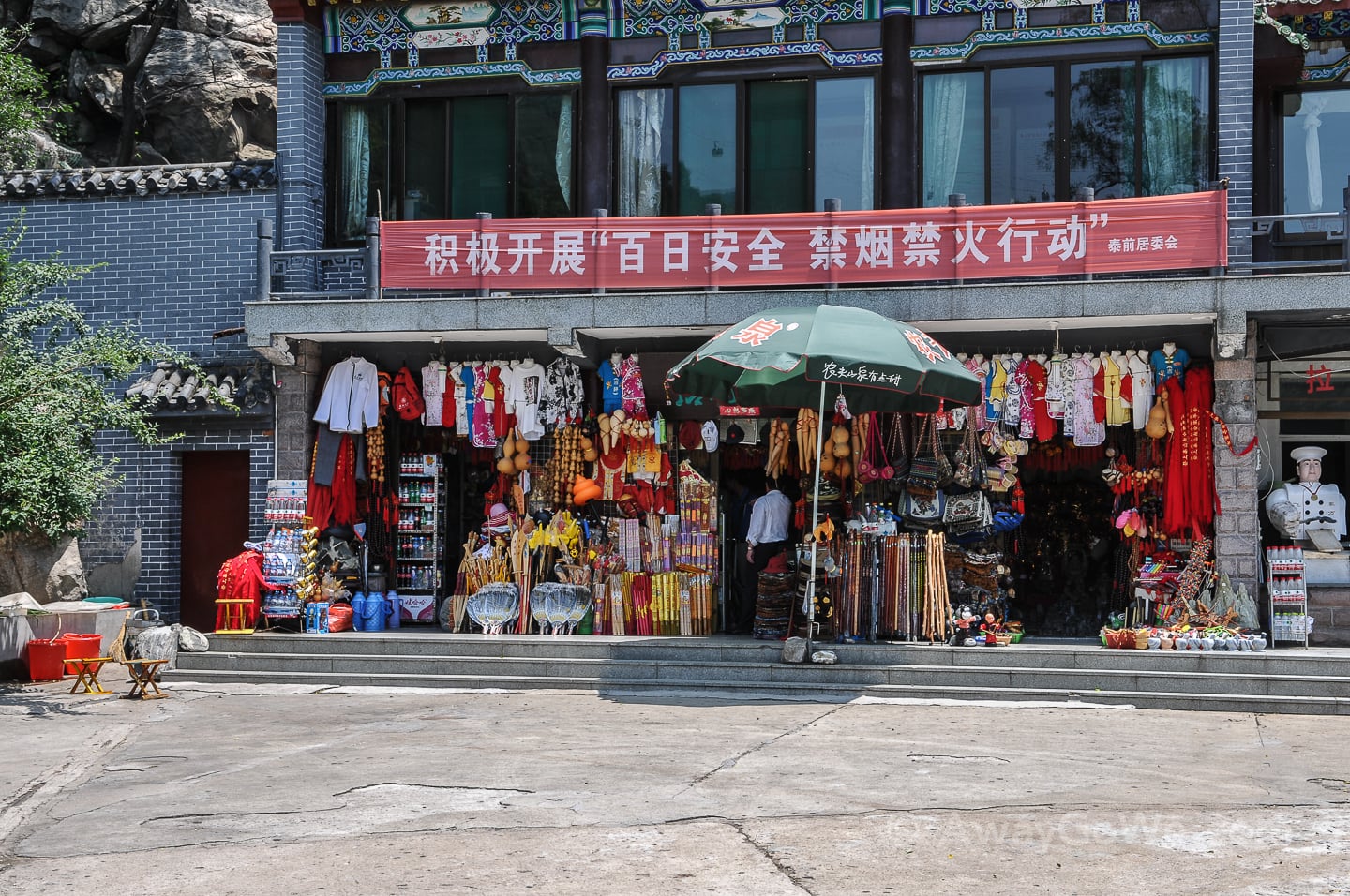
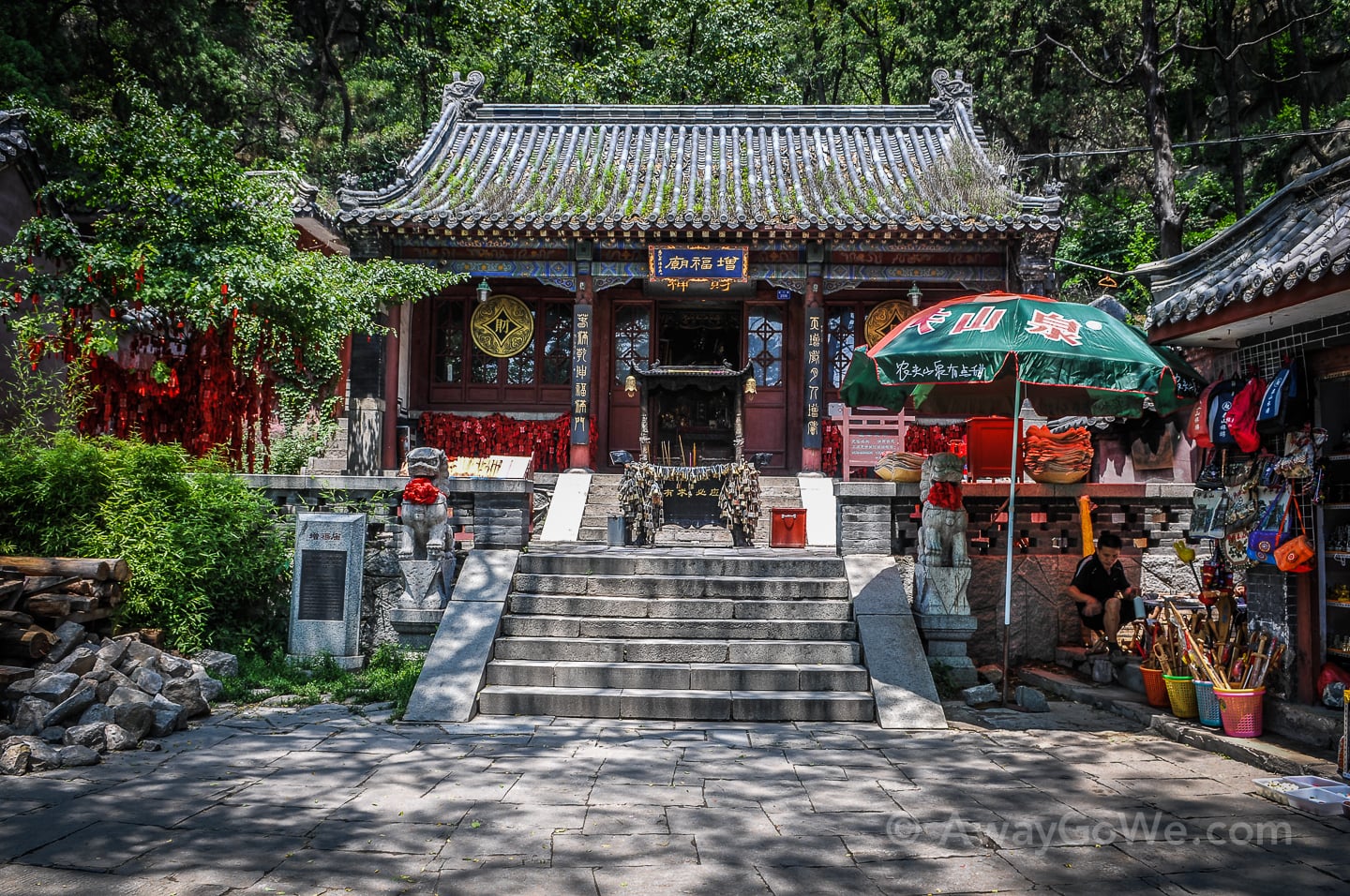
Shortly after Middle Gate to Heaven is where the main trail joins up with the bus road and the cable car station. Due to this juncture, the crowds momentarily swell as dozens of groups of tourists hopping on and off buses collide with hoards coming up from the lower half of the trail and down from the upper trail. And then there are those fighting the crowds to get across to (or come from) the cable car station. It all very closely resembled rush-hour outside of Beijing’s central railway station, but hotter, sweatier and without the romantic subtext of rail travel.
The good news is that if you’re climbing the mountain on foot, the throngs quickly dissipate after five minutes back on the stairway to heaven (or hell, if your knees have already begun to give out). After another 20 minutes, it can feel downright lonely, with only another 20 or so climbers keeping you company. But no need to worry, you’ll meet the crowds again at the grueling last climb to the Southern Gate to Heaven.
Hot Tip
So if you’re thinking of stocking up on water and snacks half way through your journey, hold off just a little while longer and you’ll be greatly rewarded.
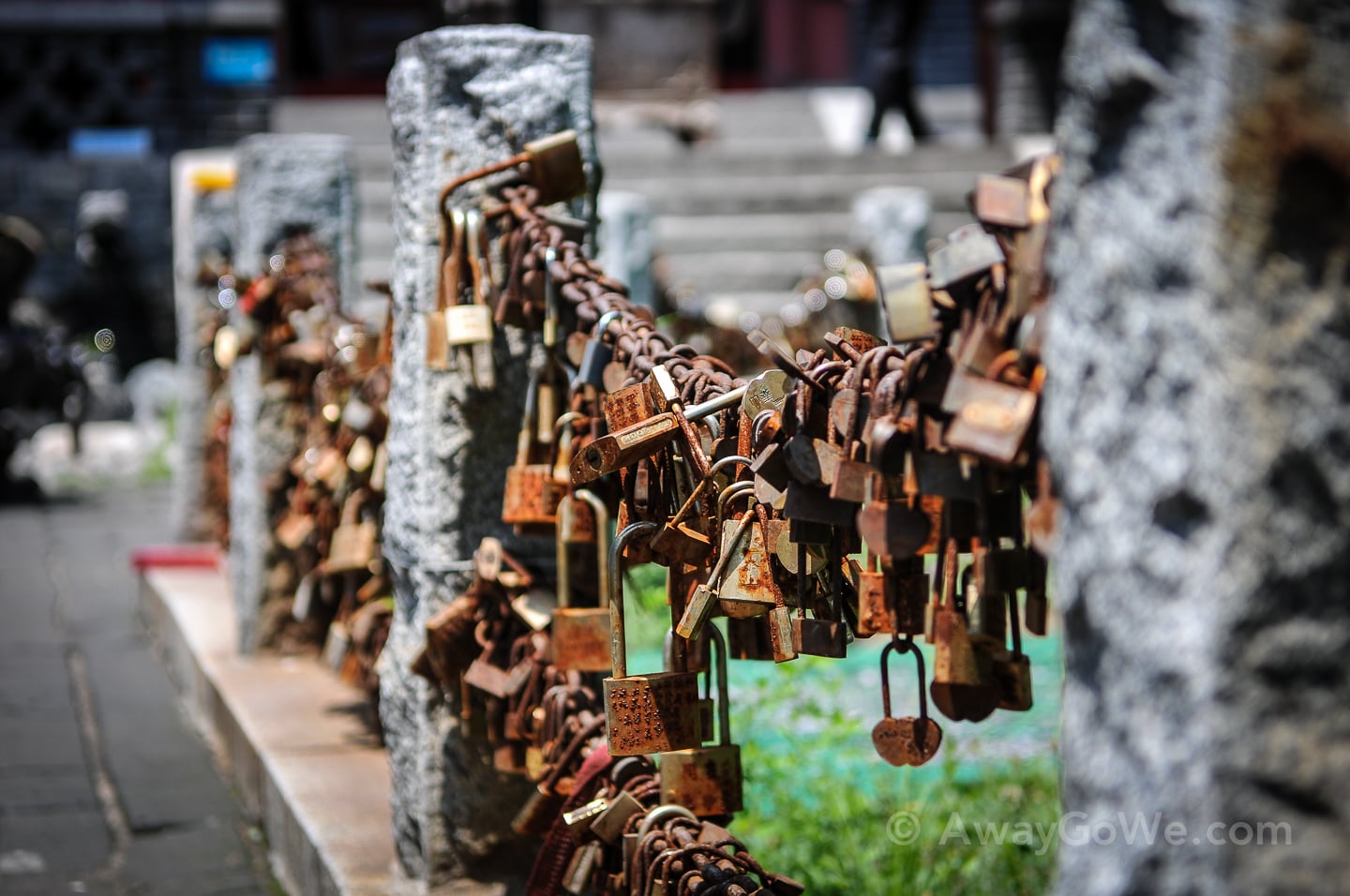
Lori and I had wondered about the significance of the hundreds and hundreds of padlocks which can be seen up the trail (especially in the many temples dotting the main trail). Unfortunately at the time, our Mandarin skills were not enough to find the answer, and what a shame. Turns out (from a quick web search) they are commonly referred to as “love locks.” In Chinese culture, it is believed that if a couple secure a lock on a high mountain in the clouds and throw away the key, their love will last forever. Given that Lori and I are technically on our honeymoon, it would have been a fitting gesture (and fun story nonetheless). Oh well.
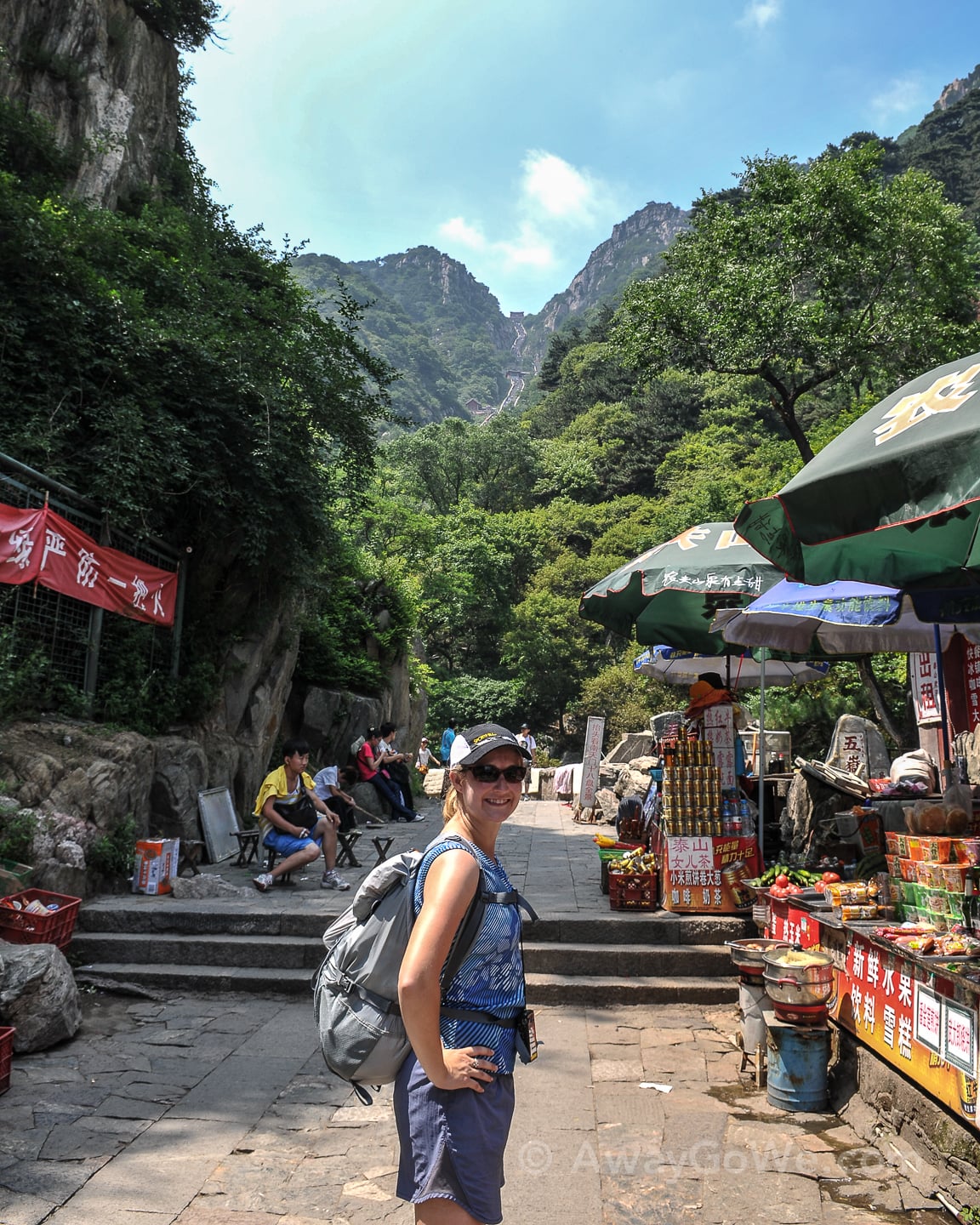
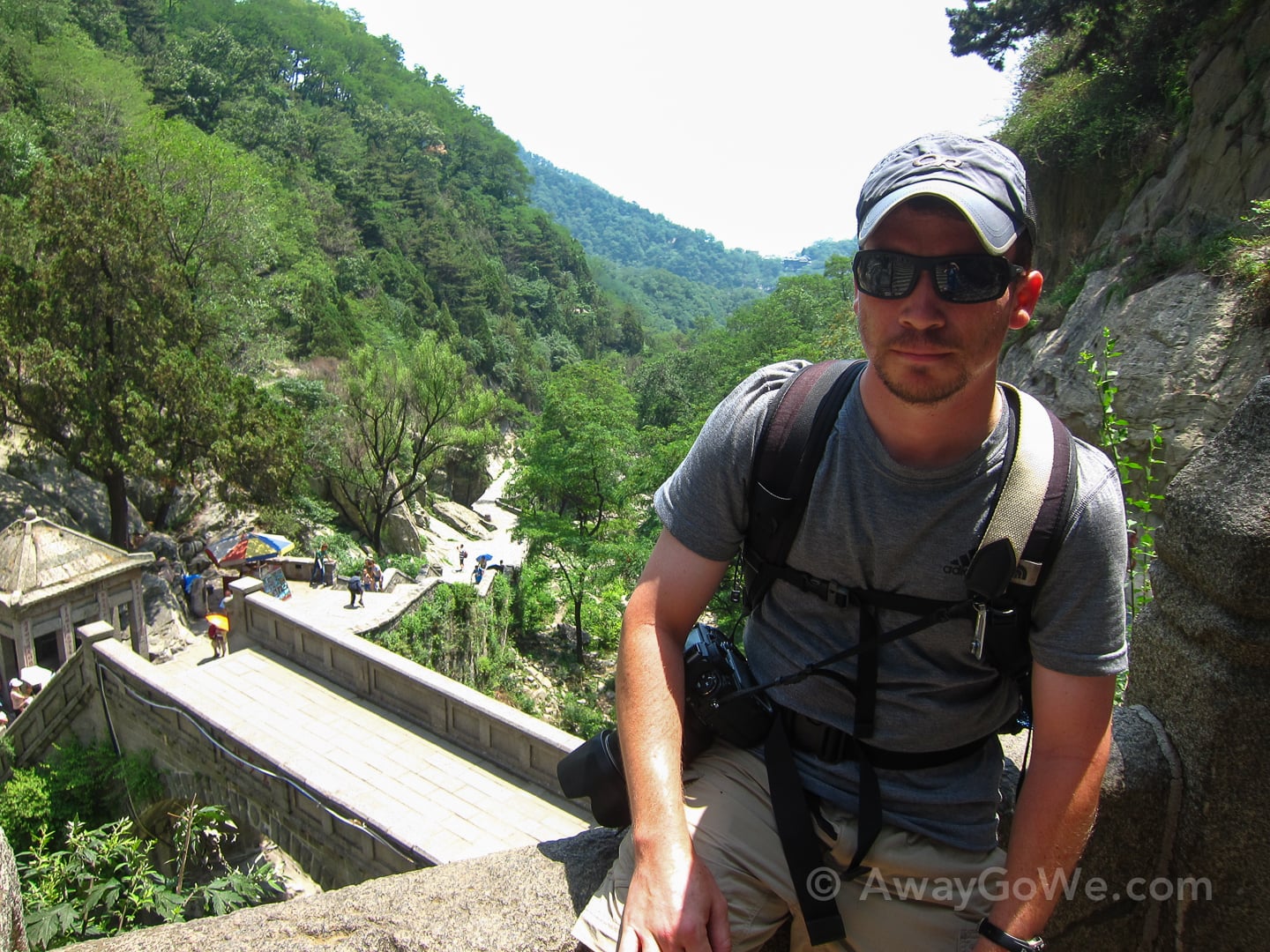
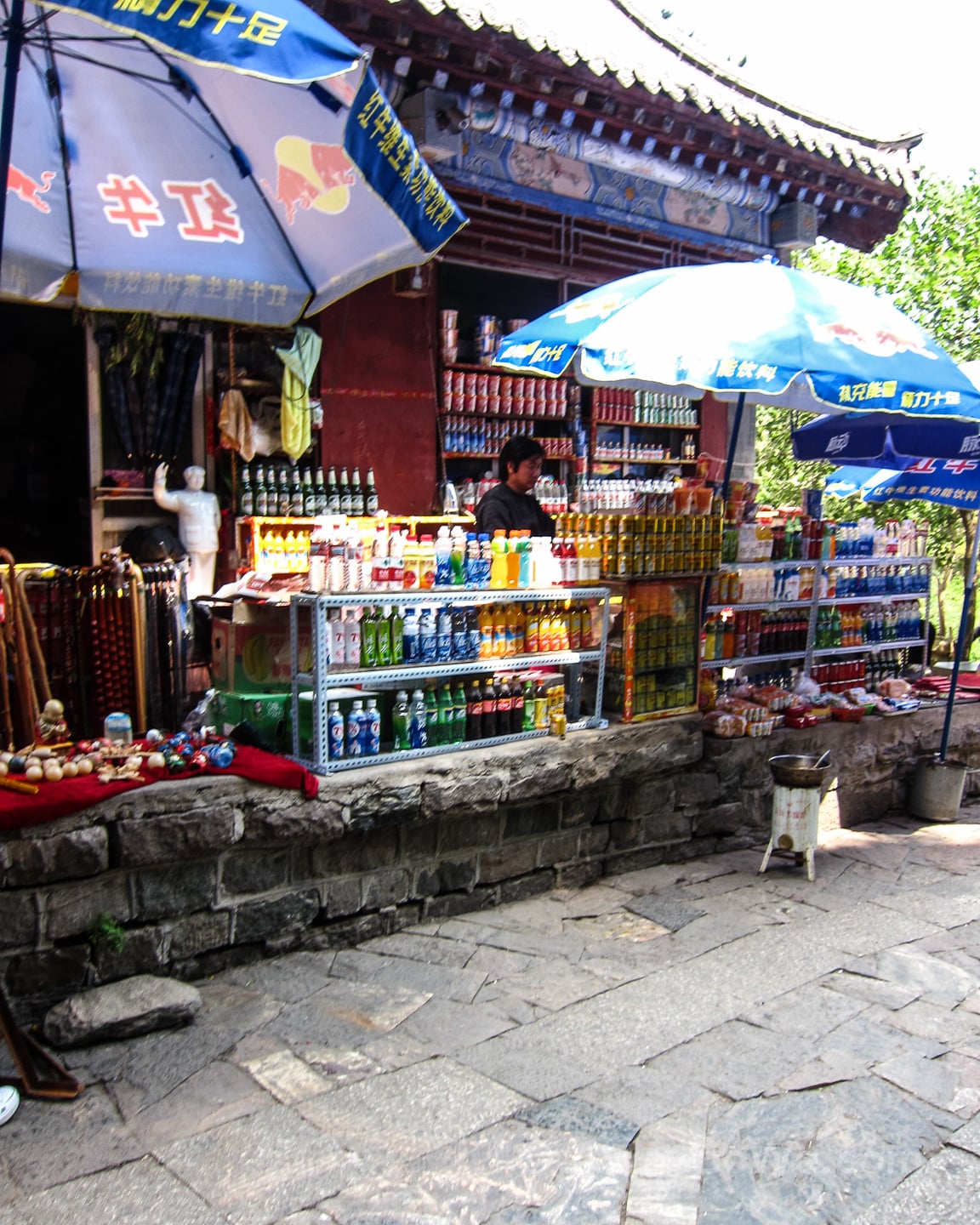
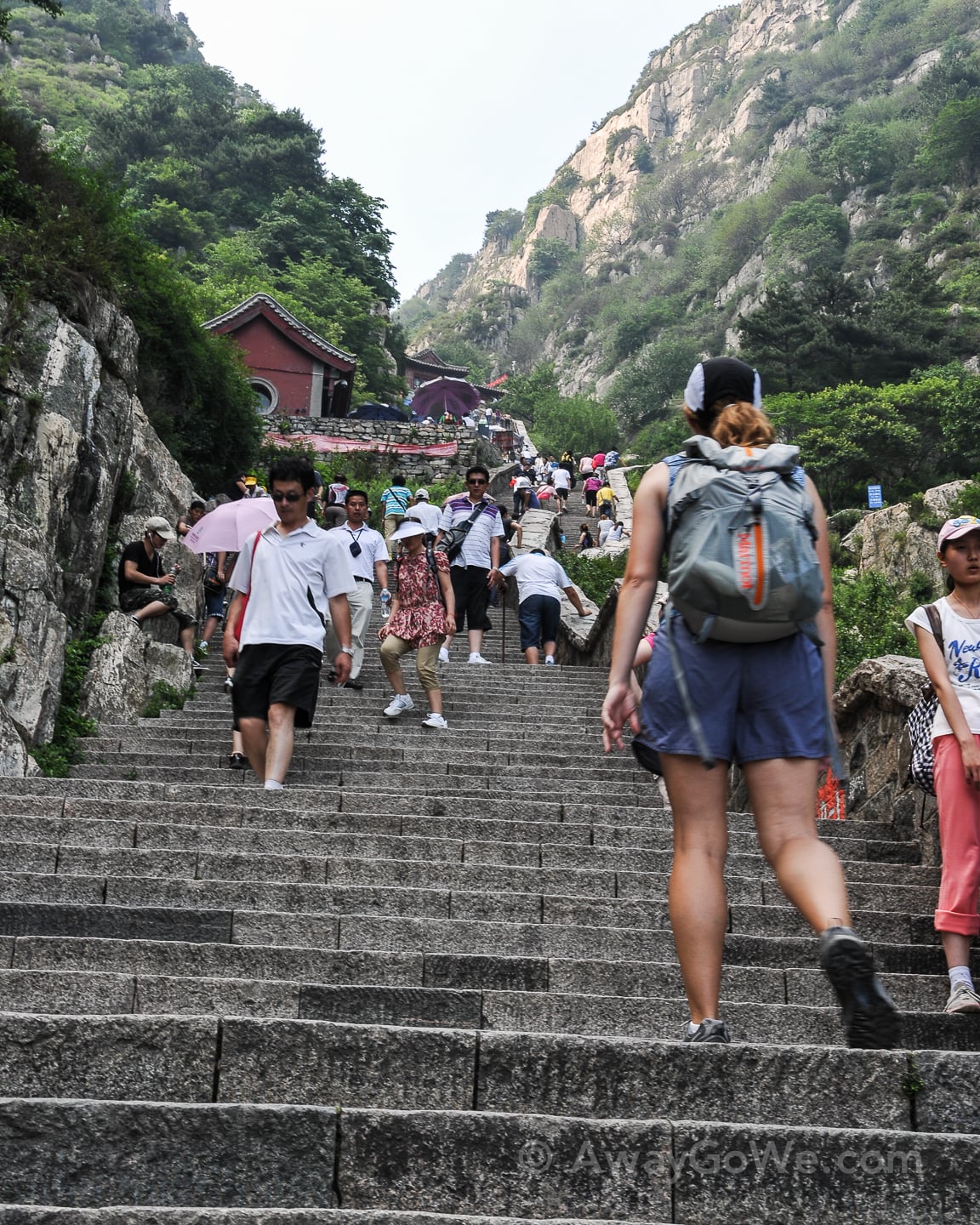

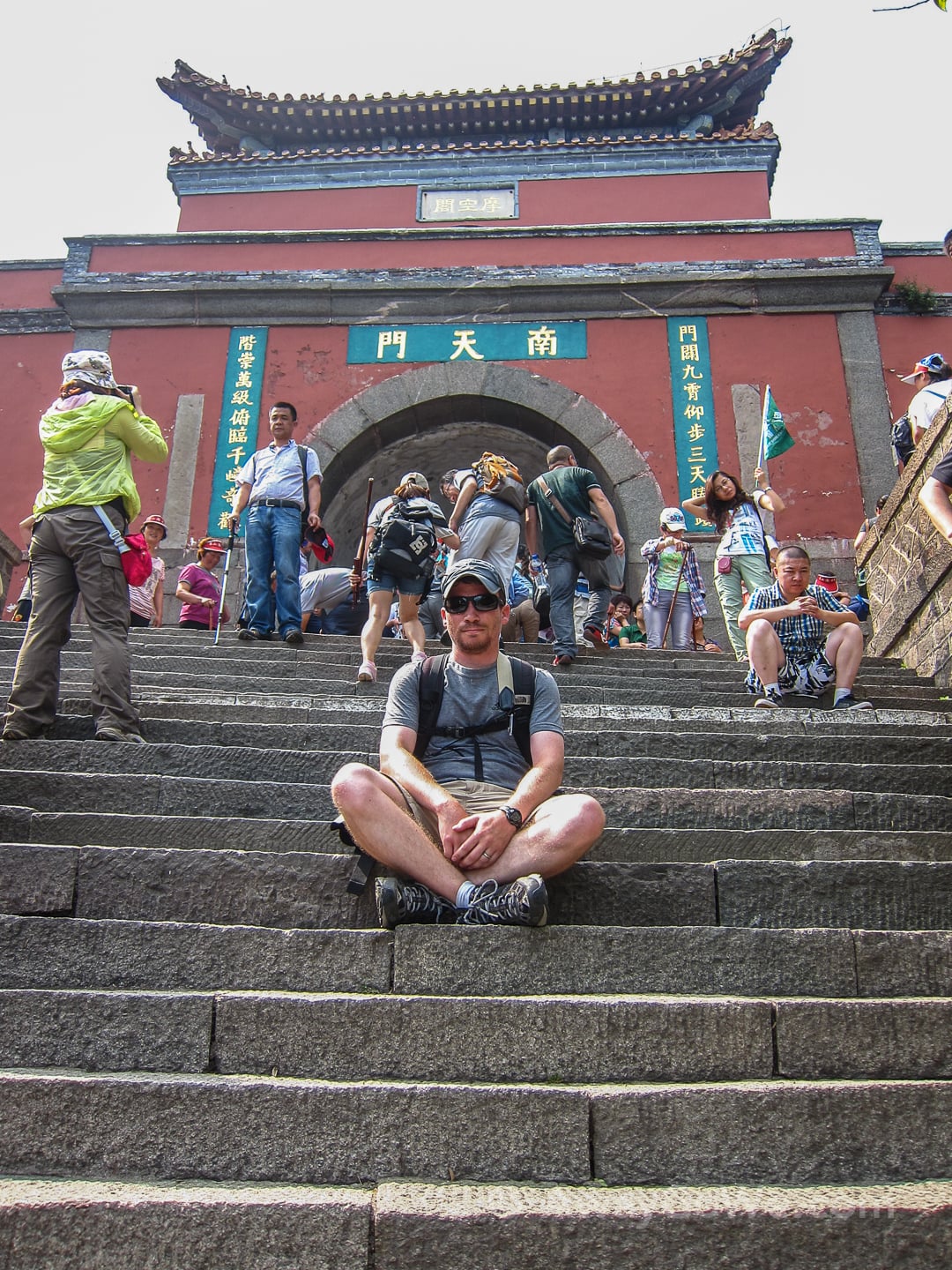
On the Mountain-top
On Taishan, in total, there are:
- 7,200 total steps (including inner temple steps), with 6,293 Official Mountain Walkway Steps, lead up the East Peak of Mount Tai, along its course.
- 1,018 cliff-side and stone inscriptions
- 819 stone tablets
- 97 ruins
- 22 temples
- 14 archways
- 14 kiosks
- 11 gates
- 4 pavilions
- Anywhere from 20 to 1 billion Chinese tourists (depending on the season)
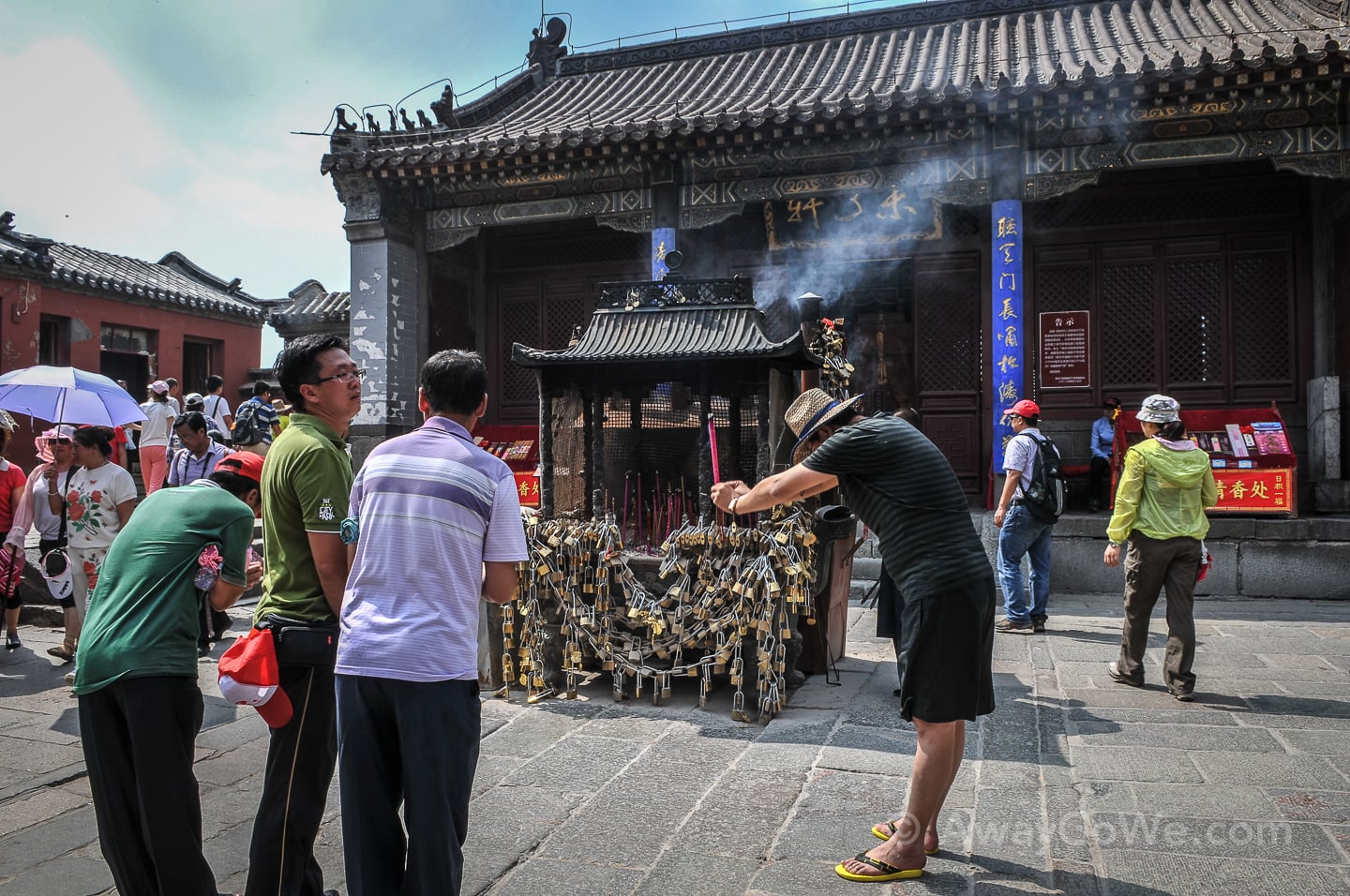
After reaching the Southern Gate to Heaven, we were greeted by a small pavilion which opens up into the sprawling village on the summit.
Let me take this opportunity to say that we found the Lonely Planet China book to be pretty useless for Taishan. The map included is not only impossible to follow, but incredibly inaccurate, and a lot of the lodging information is incorrect (especially names and locations).
Lodging on the Summit
Here’s what we were able to find in terms of lodging on the summit. There are two solid hotel options and 2+ potential budget options. We stayed at the Xian Ju Hotel (also styled Xianju Hotel or Xianju Binguan) which is located on your immediate left after ascending through the first gate in the summit village complex. It can further be identified by the yellow and red flags and army jackets which are rented in the evening out front.
At reception, the posted placard says rooms start at a staggering 600 RMB ($95 USD!). Don’t you fall for it! The one thing our LP book was useful for was its tip to ask for a discount. Knowing all of three words of Mandarin, we still were able to dicker with the front desk (with the aid of a few phrases we pointed to such as “How much is a room?” and “Can you offer a discount?”) We didn’t think it could possibly work for us, but by simply pointing to these two questions in our phrasebook, we were able to get a 50% discount from the posted 600 RMB to a more reasonable 300 RMB (still $47, but by far the best deal currently on the summit of Taishan but for a few very budget exceptions)! Read more about Xian Ju Hotel in our Accommodations Review section (review forthcoming).
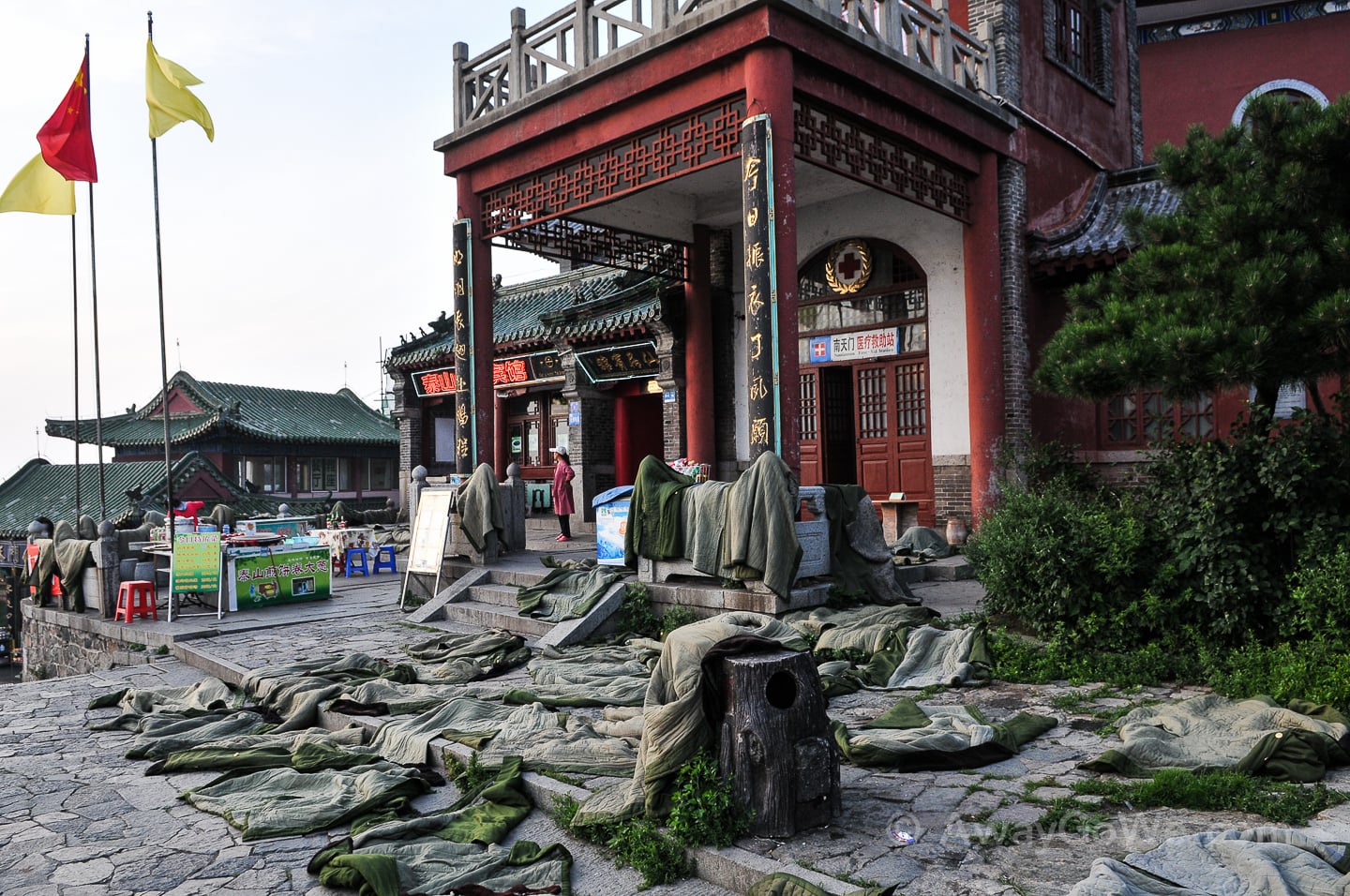
The only other fully legit place on the summit that we could spot was the swanky Shenqi Hotel near the top of the mountain next to the Confucian Temple (up a long flight of stairs with red and yellow flags).
We also came across what appeared to be two potential budget accommodations (though we haven’t been able to verify this, given our limited Mandarin). The first one is a complex of very basic rooms below the Xian Ju Hotel on the first road leading from the Southern Gate to Heaven complex. The second was discovered during a toilet visit off the main road (below). It’s basically a series of rooms hidden behind one of the shops (you have to walk through an alleyway that doubles as a curio store). If your Mandarin is good, you can probably find it pretty easily, but if you’re Mandarin-challenged like we are, you may easily find yourself in the back of a dark alley in a semi-sketchy (and exceedingly awkward) situation.
We also saw a few random tents scattered about the summit, but have no idea if this is condoned, simply tolerated, or if the campers just got lucky.
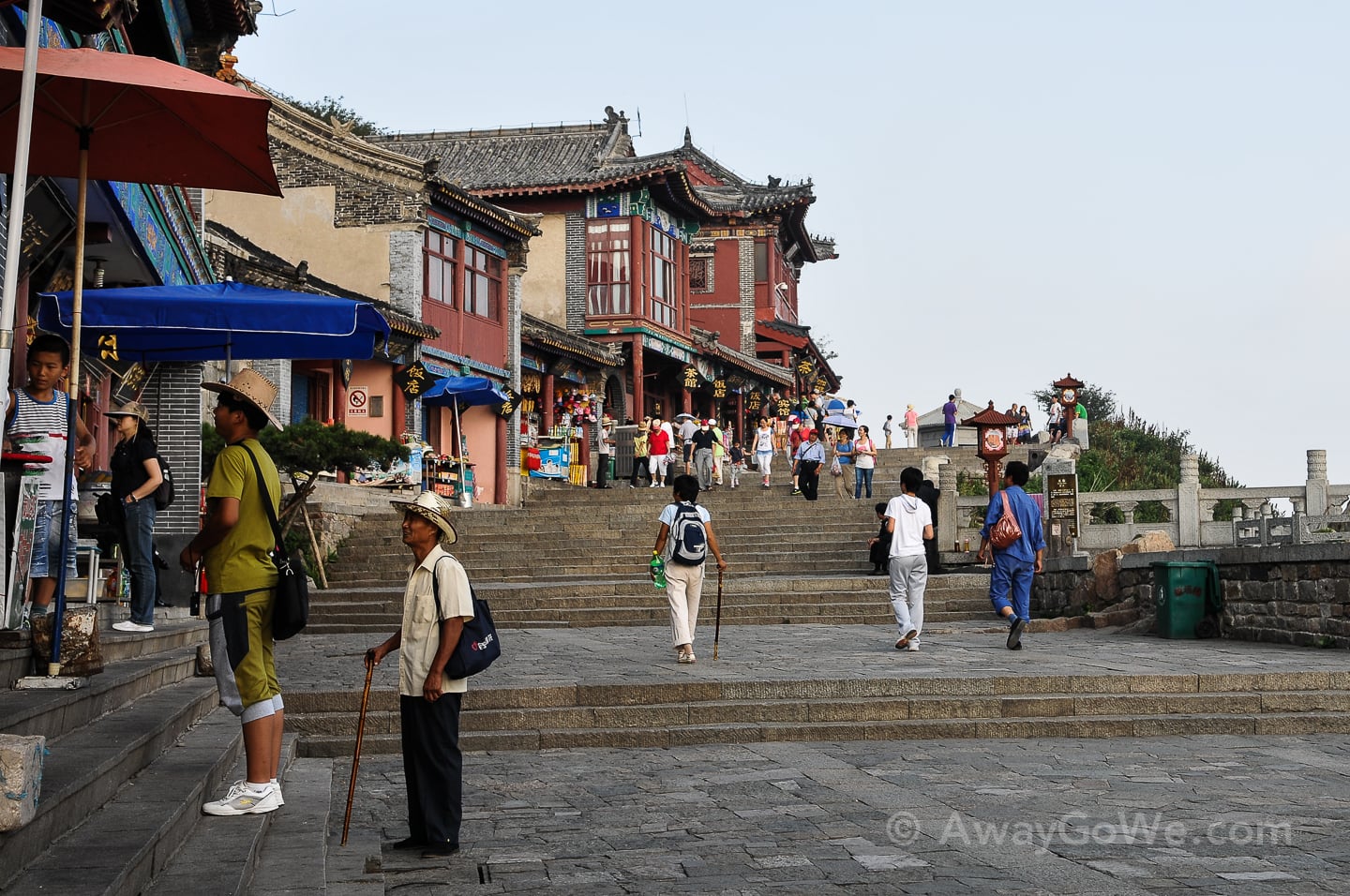
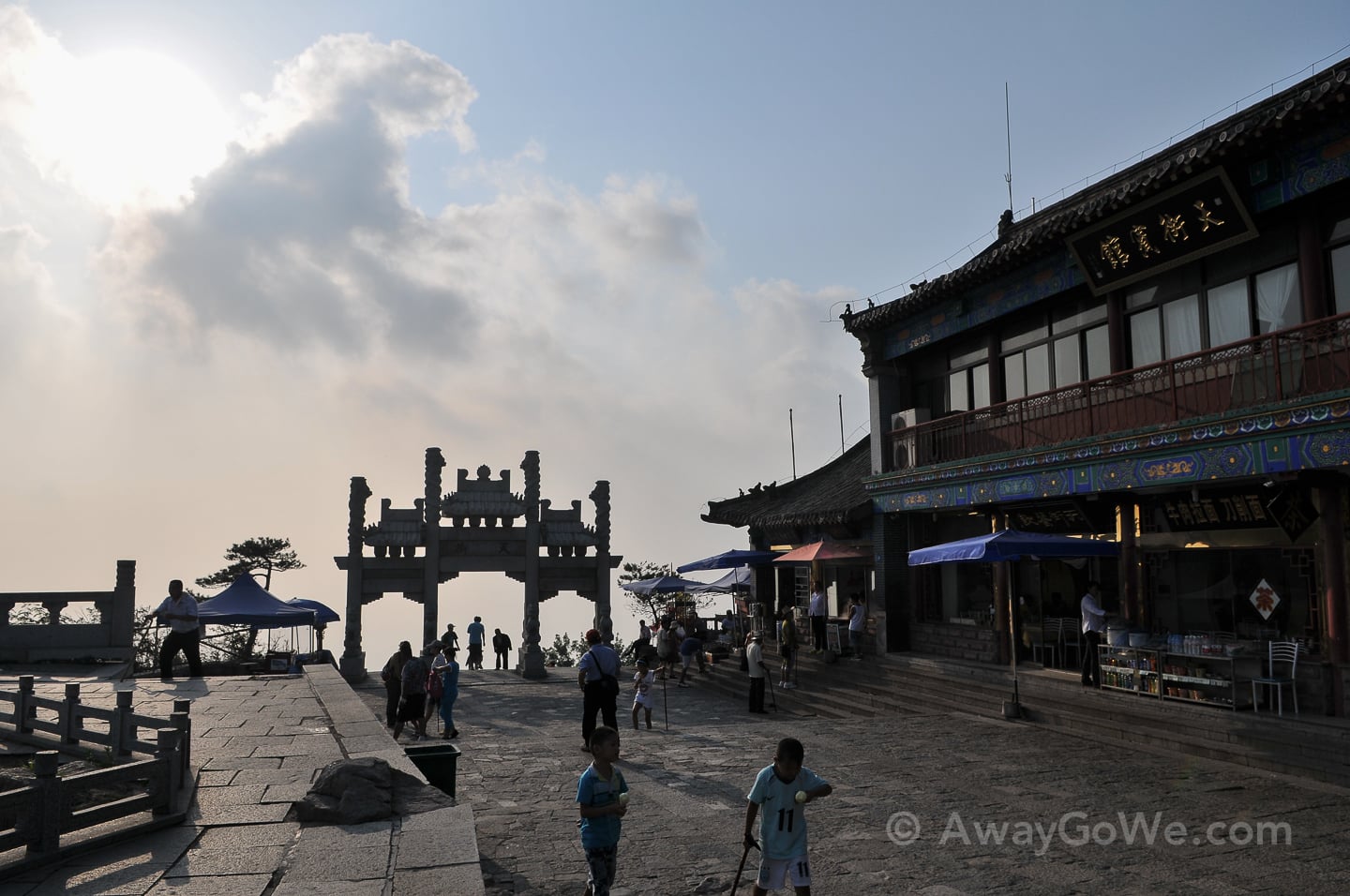
Eating & Drinking
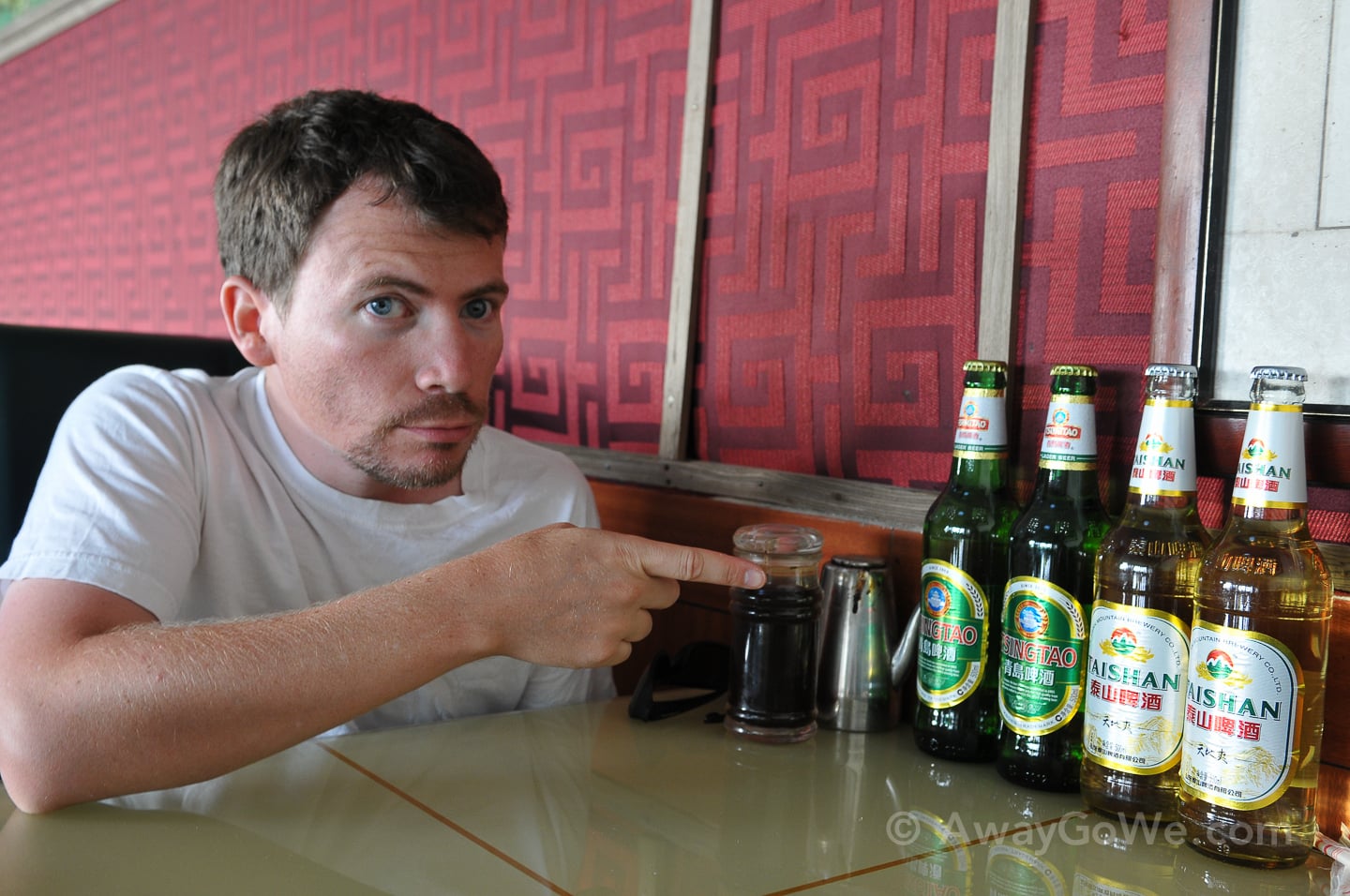
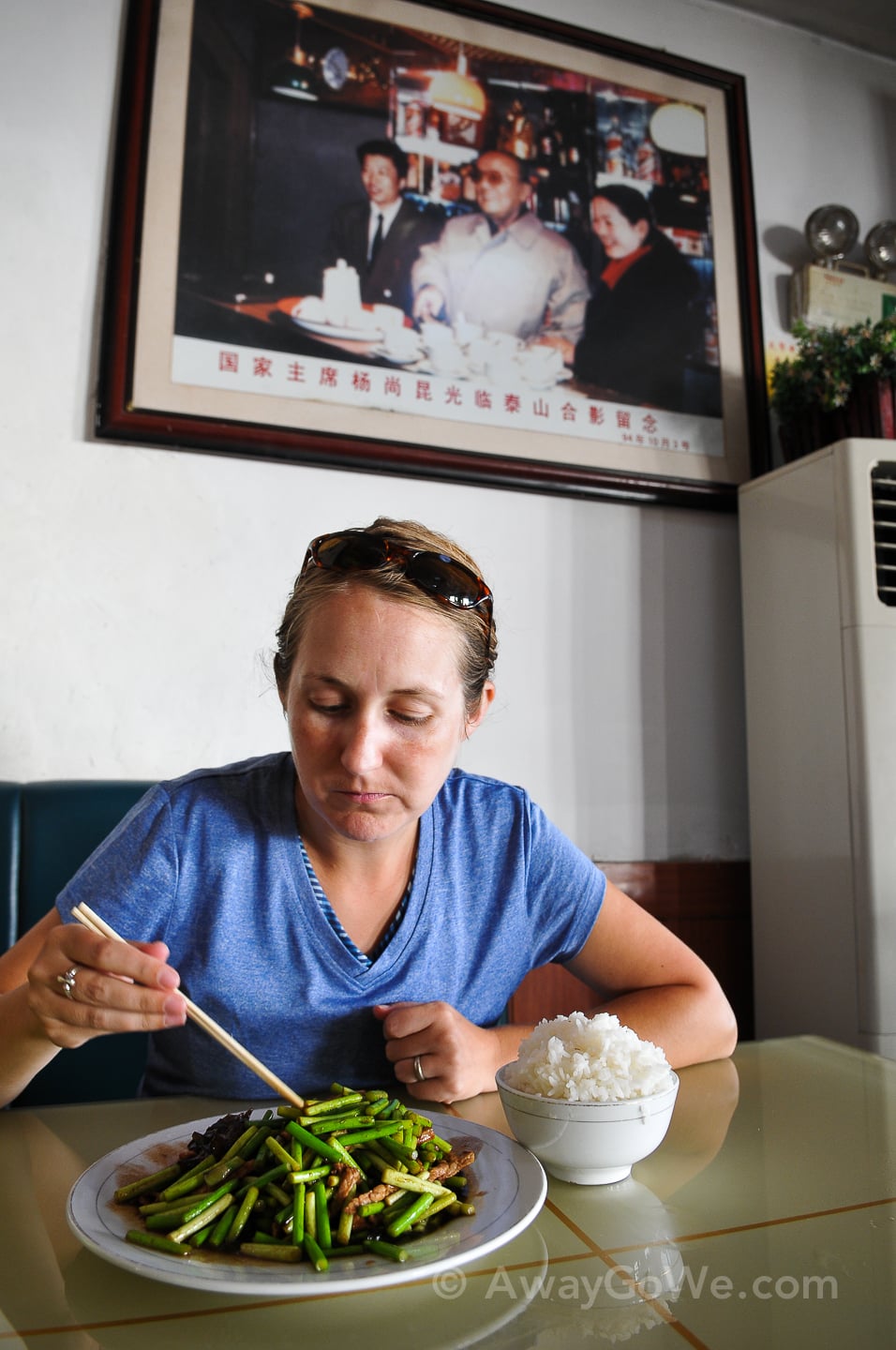
As is often the case atop mountains, dining options are quite limited on the summit of Taishan. Don’t expect to find a western cafe with a killer view because you won’t find it on this mountain. What you will find is standard Northern Chinese cuisine done well for big-city local prices, accompanied by the local Taishan street food offerings such as savory “Taishan pancake” (look for the women spinning dough on a wheel), the all-pervasive wiener wrap, and fried bread sticks (the latter was our favorite). Expect also to find instant noodles (apparently the official food of the Taishan mountain climber) in great abundance.
Snack supplies and toilet paper are extremely hard to find on the summit, so it is strongly advised to bring your own.
